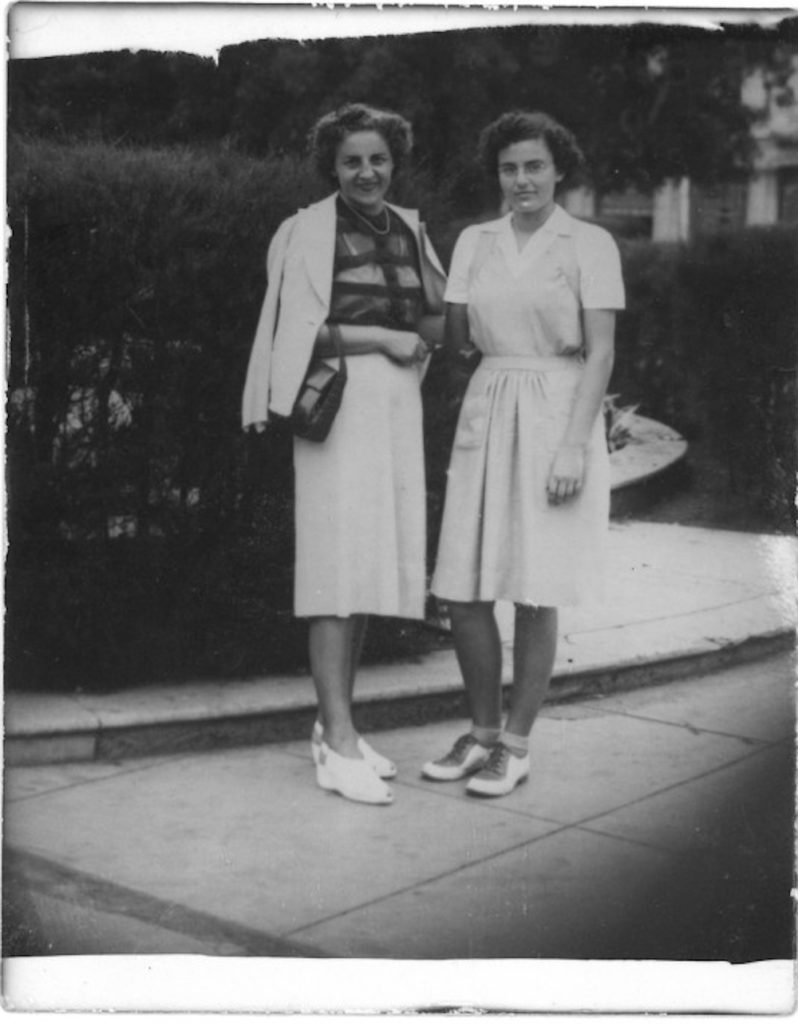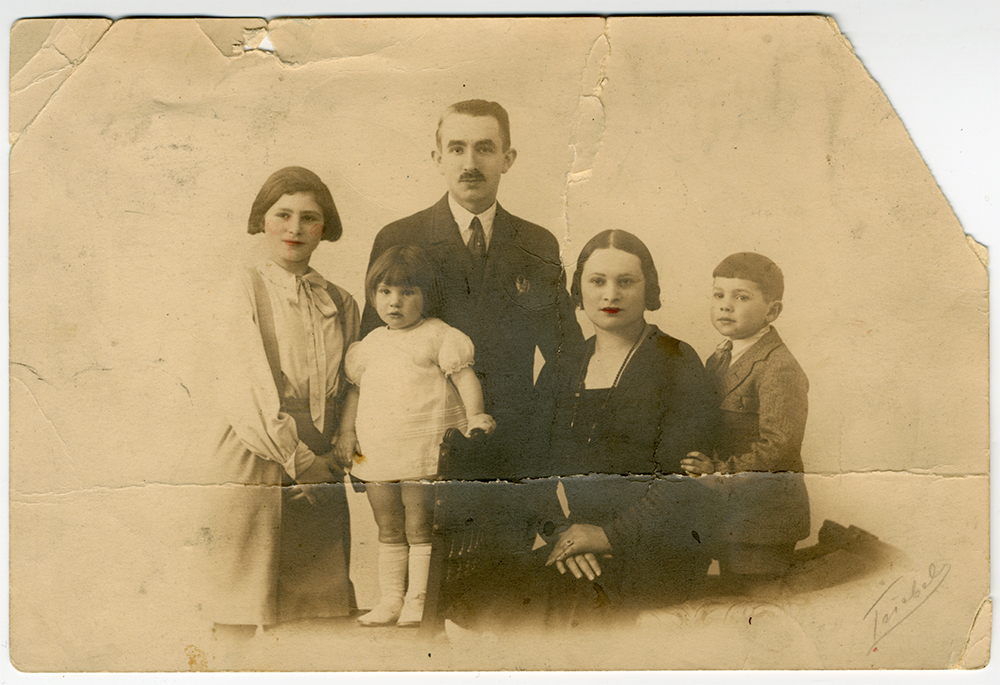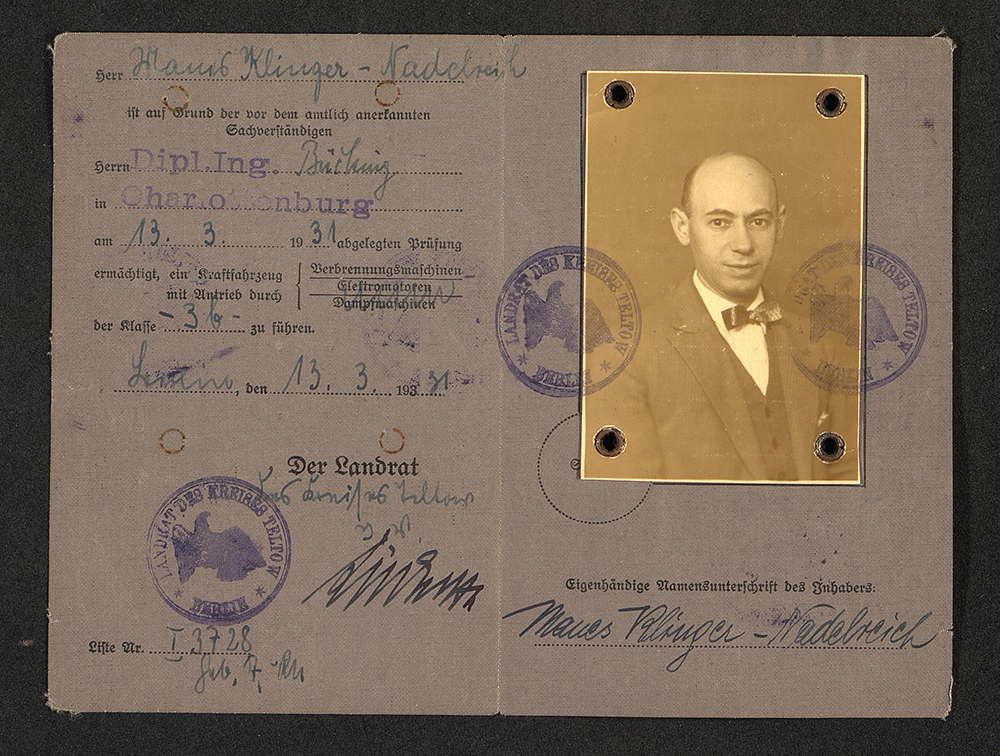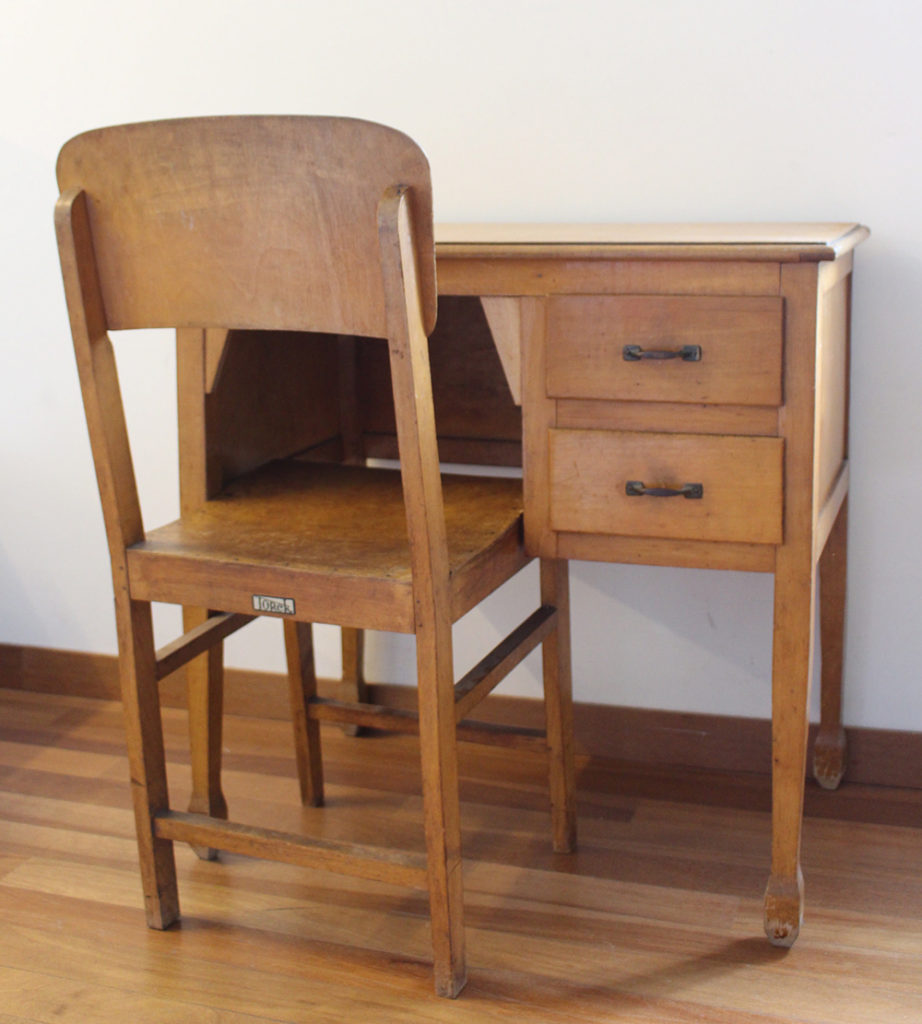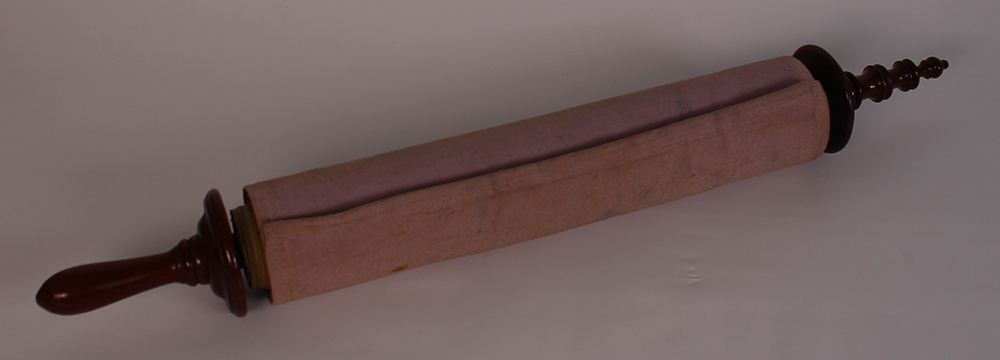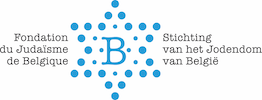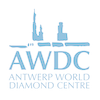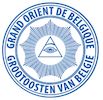Fact and fiction are polar opposites. Or aren’t they? History is increasingly dressed up as fiction, and the Holocaust is a prime example of this. Graphic novelists have been tackling the subject of the Holocaust since the 1970s: at times with apprehension and hesitation, but also with respect. Art Spiegelman’s graphic novel ‘Maus’ has acquired a place in the literary canon, but many other cartoonists have also sought to address the subject of the Holocaust through their work. In the exhibition, more than 200 comic strips, graphic novels and manuscripts guided visitors through the fictionalization of the Holocaust.
Read more Annual report
Annual report 2019
Introduction
The theme of Kazerne Dossin in 2019? Liberation, ‘75 years on’. The stories of victims were told as we remembered the last eight convoys to leave Dossin barracks 75 years ago. In October we opened the exhibition ‘auschwitz.camp’, which brought large numbers of visitors to Mechelen in the last months of the year. Kazerne Dossin also lent its expertise to local, national and international commemorative initiatives and welcomed 1,500 visitors through its doors during the liberation edition of Open Monuments Day.
In 2019 we reaped the rewards of our network approach. The polarization-related network ’wij-zij’ gathered momentum with weekly training sessions. European educational and scientific cooperation flourished as a result of our expertise. Kazerne Dossin was able to add another 200-plus portraits to its wall of portraits and databank. And thanks to agreements with partner institutions elsewhere, a number of countries can now access the databank. Authentic portraits by Irene Spicker were carefully restored, thanks to the University of Antwerp’s Conservation-Restoration department. With our three guest exhibitions – ‘Eugeen Van Mieghem’, ‘Left Luggage’ and ‘Exodus’, - we managed to reach a new public. Our public events also benefitted from outside collaboration. And two film screenings and numerous book presentations organized in association with producers and publishers attracted a good deal of interest.
To look back in time is to cherish the successes and digest the setbacks. We could no longer be ambiguous. In the year when visitor numbers fell just short of 80,000 – a considerable increase on the previous year -, we also said goodbye to Christophe Busch and found ourselves the focus of a media storm. The debate on social media and in the press deeply affected our organization. It was painful to find that Kazerne Dossin – the very place where truths must prevail over all too easy polarization – was in the eye of the storm. The discussion about how Holocaust and Human Rights can be linked escalated to the point where we had to ask ourselves if we should continue down that path. Unjustly so, because neither team nor Board had any doubts about this dual mission. The how question remains. Kazerne Dossin will always be a place of differing visions as to how we should address an emotive history and the challenges we stand for as society. But that is good, it makes us stronger. It does, however, require serenity and space for debate. We must keep that space and do even more to preserve it, not only in-house, but also in society. We want to learn from it so as to step confidently into 2020.
2019 in figures
- Holocaust and Comics
- Eugeen van Mieghem
- Left Luggage
- auschwitz.camp
- Exodus
- 33.299 Kids and youngsters (in group or individually)
- 11.658 Adults on training courses
- 43.676 Adults in their free time
- 122.650 Unique visitors to the website
- 7.602 Followers on social media
- 78.965.451 Readers and viewers of 618 items
2019 in a nutshell
 Beeld: Yslaire, Ontwerp: Anderzijds
Beeld: Yslaire, Ontwerp: Anderzijds
Special exhibition: Holocaust and comic strips
17.09.2018 - 23.06.2019
To mark Holocaust Remembrance Day, Senior Researcher Dr Laurence Schram gave a talk in the Chamber of Deputies.

On International Holocaust Remembrance Day, Kazerne Dossin screened ‘Cuba’s Forgotten Jewels’ at the UGC cinema in Antwerp in association with the Red Star Line Museum and the Peace Centre.
The same day, kazernedossin.memorial went live. This online website commemorates the more than 25,500 victims deported from the transit camp at Dossin barracks.


In the presence of the press, Judy Kreith – who made the ‘Cuba’s Forgotten Jewels’ documentary – presented Kazerne Dossin with a suitcase belonging to her mother Marion Kreith. During the war, Marion managed to avoid deportation by fleeing to Havana.
Read more
Ballon Media and author Emile Bravo present the new Spirou album “Hope in frightened days – part 1” in Kazerne Dossin.

Kazerne Dossin and Cinemien organized a preview of ‘Werk Ohne Autor’ (Never Look Away). Kazerne Dossin’s Dr Veerle Vanden Daelen introduced the film.

Curator Erwin Joos and Alderman for the Port of Antwerp Annick De Ridder opened the guest exhibition ‘Eugeen van Mieghem 1875-1930 and the Emigrants of the Red Star Line’.
 (c) Eugeen Van Mieghem
(c) Eugeen Van Mieghem
Guest exhibition : Eugeen van Mieghem 1875-1930 and the Emigrants of the Red Star Line.
08.02.2019 - 26.03.2019We are all too familiar with images of large groups of immigrants looking to settle in Europe. Some one hundred years ago the situation was in reverse: millions of people emigrated from Europe to the United States of America in search of better living conditions. Around a century ago the Antwerp social artist Eugeen van Mieghem (1875-1930) movingly depicted the many Jewish migrants in Antwerp about to embark on the Red Star Line for the United States. In the period 1873-1934, the Red Star Line transported approximately two million emigrants and Antwerp was one of the most important embarkation points in Europe.
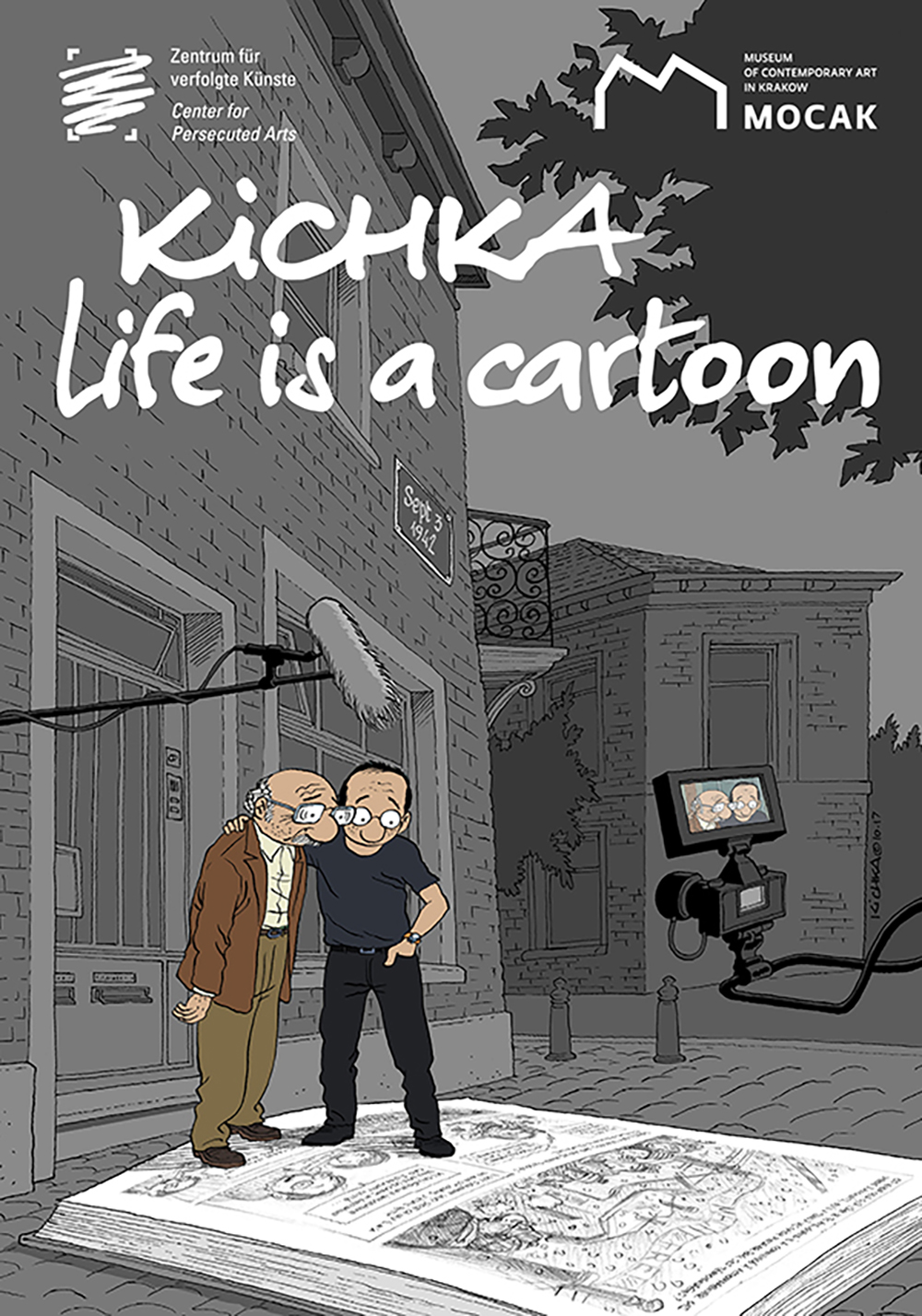
Kazerne Dossin and Filmhuis Mechelen organized a screening of the film ‘Kichka: Life is a cartoon’ about the relationship between Holocaust survivor Henri Kichka and his son Michel.

In collaboration with the education support organization Démocratie ou Barbarie, Kazerne Dossin organized its annual Teachers’ Day for all French-speaking teachers from primary and secondary schools and higher education institutes. Thirty-three teachers attended. The theme was the conceptualization of genocide.
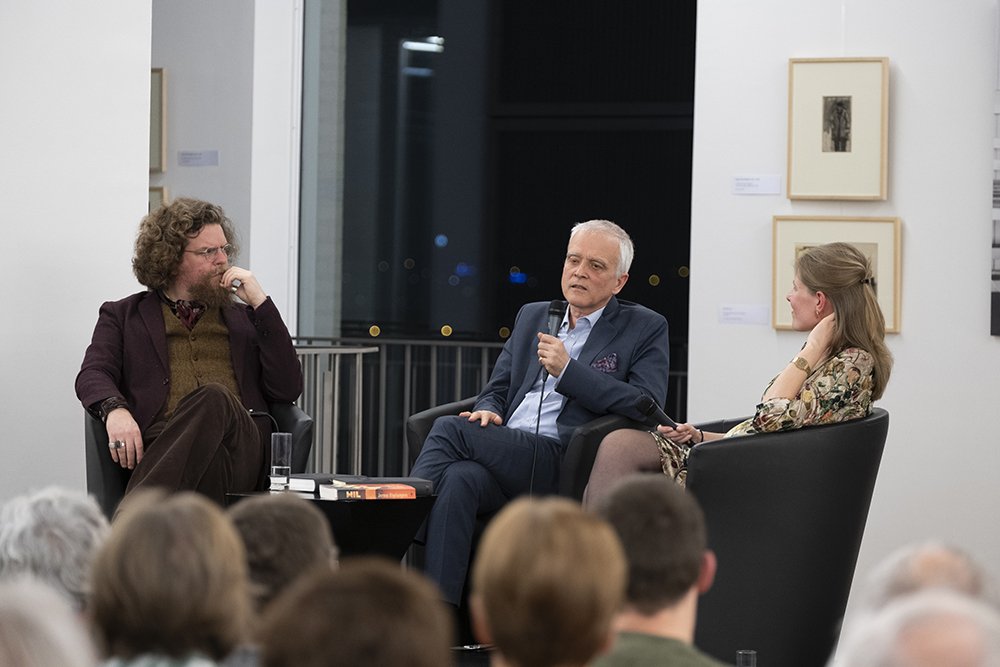
Herman Van Goethem, author of the book ‘1942. Het jaar van de stilte’ (1942. The year of silence) talked to writer Jeroen Olyslaegers. Together they reflected on 1942, a turning point in the Second World War. 165 people came to listen to the discussion.

According to anthropologist Rik Pinxten, there is a real need for us all to evolve from distrust to renewed trust. He presented his latest book ‘Het nieuwe vertrouwen’ (The New Trust) in which he shared his alternatives to a fossilized ideology.

Opera Vlaanderen presented a new opera based on Jonathan Littell’s novel Les Bienveillantes (The Kindly Ones). Christophe Busch, the makers of the opera and other experts elucidated the creation during a round table discussion.
Read more
During the Easter holidays, Kazerne Dossin put the spotlight on the schools programme, giving teachers and their guests the opportunity to scrutinize both the permanent and special exhibitions free of charge. No fewer than 345 teachers and partners came along for inspiration.
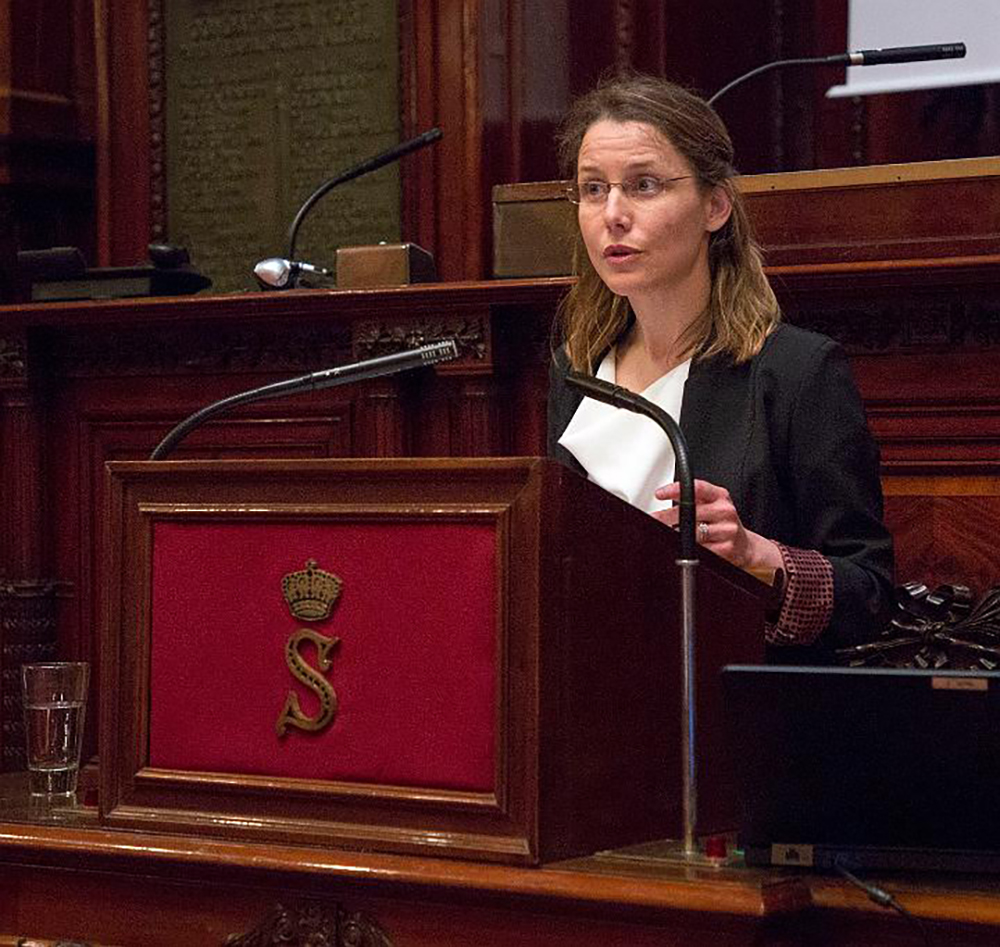 (c) Kevin Oeyen - Belgische Senaat
(c) Kevin Oeyen - Belgische Senaat
 (c) Kevin Oeyen - Belgische Senaat
(c) Kevin Oeyen - Belgische Senaat
On Liberation Day of Belgium, which is marked annually, Veerle Vanden Daelen gave a talk in the Senate. This was followed by an interview with Norbert Vos – who as a boy during the war went into hiding – and his ‘sister-in-hiding’ Mona Verhaeghe. Jacques Brotchi, who also went into hiding as a child, then gave a personal account of his experience.
 sdr
sdr
Dr Veerle Vanden Daelen and Dr Laurence Schram made a contribution to the 12th Contact Day arranged by the Institute of Jewish Studies (University of Antwerp). Its purpose is to facilitate contact between researchers working in the field of ‘Jewish Studies on the Low Countries’ and to give them the opportunity to present their research.

During the second edition of Mechelen Museum Night, culture-lovers were able to visit seven cultural venues, including Kazerne Dossin, with just one ticket. 355 people seized the opportunity.

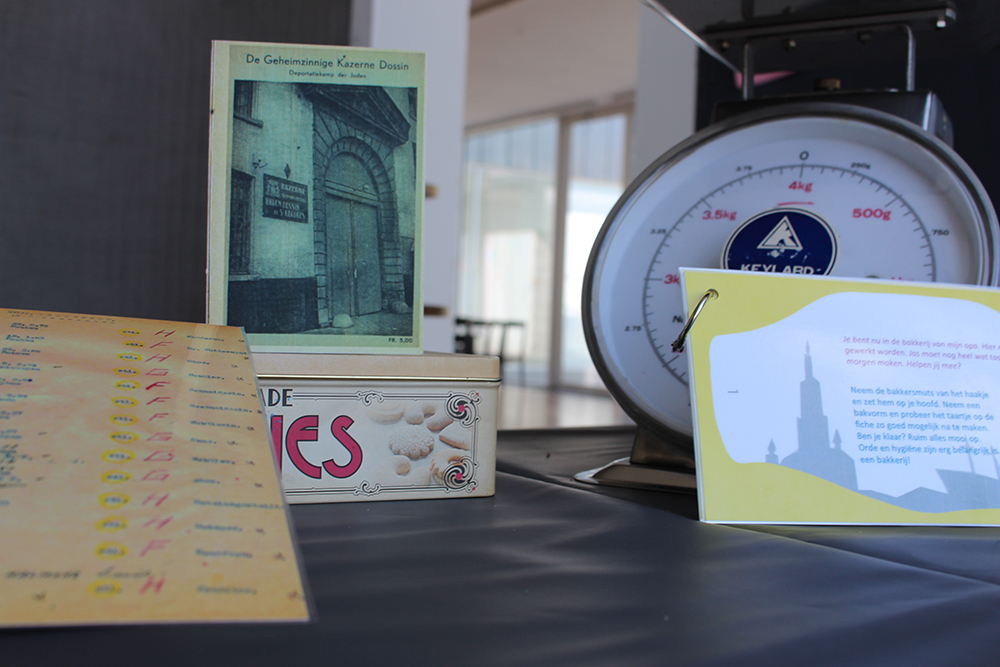

During the summer holidays, the museum hosted ‘Jos Hakker’s bakery’. As part of Fly’s Treasures (Schatten van Vliegen), we invited children to come and visit pastrycook Jos’ bakery at Kazerne Dossin and to hear his life story.
 (c) Willy Baeyens
(c) Willy Baeyens
Guest exhibition : Left Luggage
16.07.2019 - 15.09.2019Following an emotional visit to Dossin barracks, artist Willy Baeyens made a series of portraits. They were brought together in an installation consisting of more than a hundred old, seemingly abandoned suitcases. Each case contains a portrait (oil on canvas) of a child whose young life was suddenly interrupted by the horror of the Holocaust. Most of the children died, some survived, a few managed to escape the horror and still had hopes for the future. A walk past and in-between the suitcases, makes the fear, pain and grief almost tangible.
Read more
Kazerne Dossin commemorates the liberation of the Dossin Barracks 75 years ago. During a projection portraits of deportees who could be liberated can be seen.
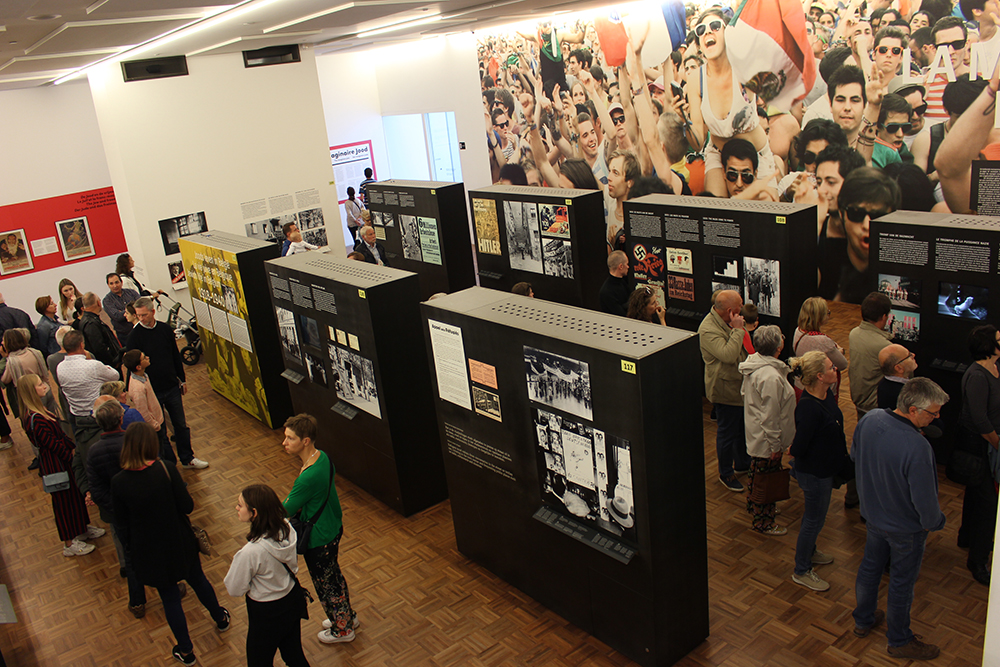

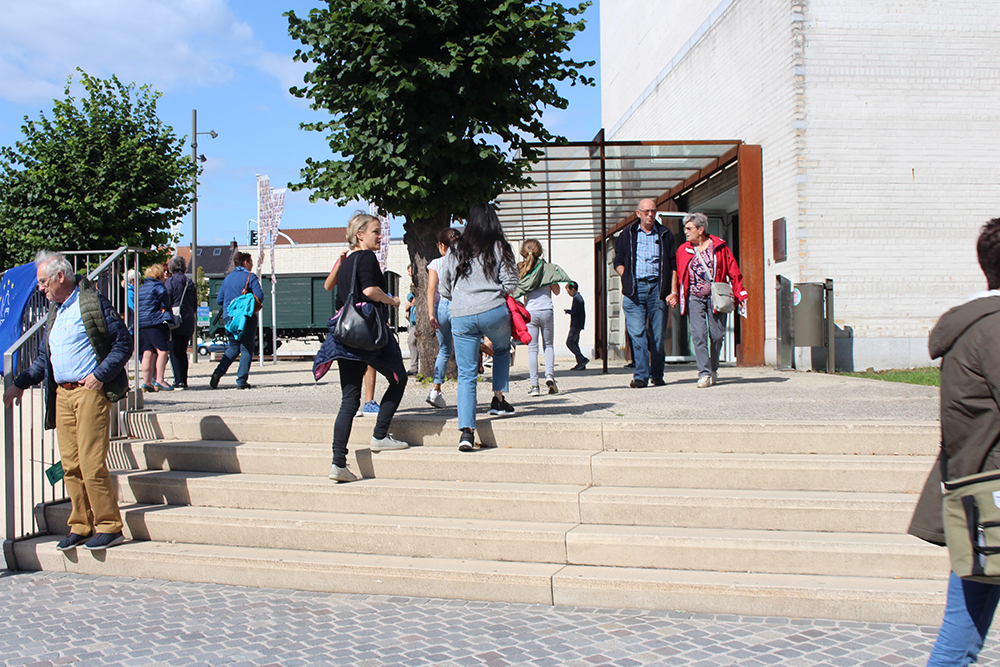



Kazerne Dossin opened its doors to visitors free of charge on Open Monuments Day, the largest monuments festival in Flanders. Given that in 2019 it was 75 years since Dossin barracks was liberated, the theme was ‘liberation’. Experts spread around the museum shed light on the subject to no fewer than 1,549 visitors.
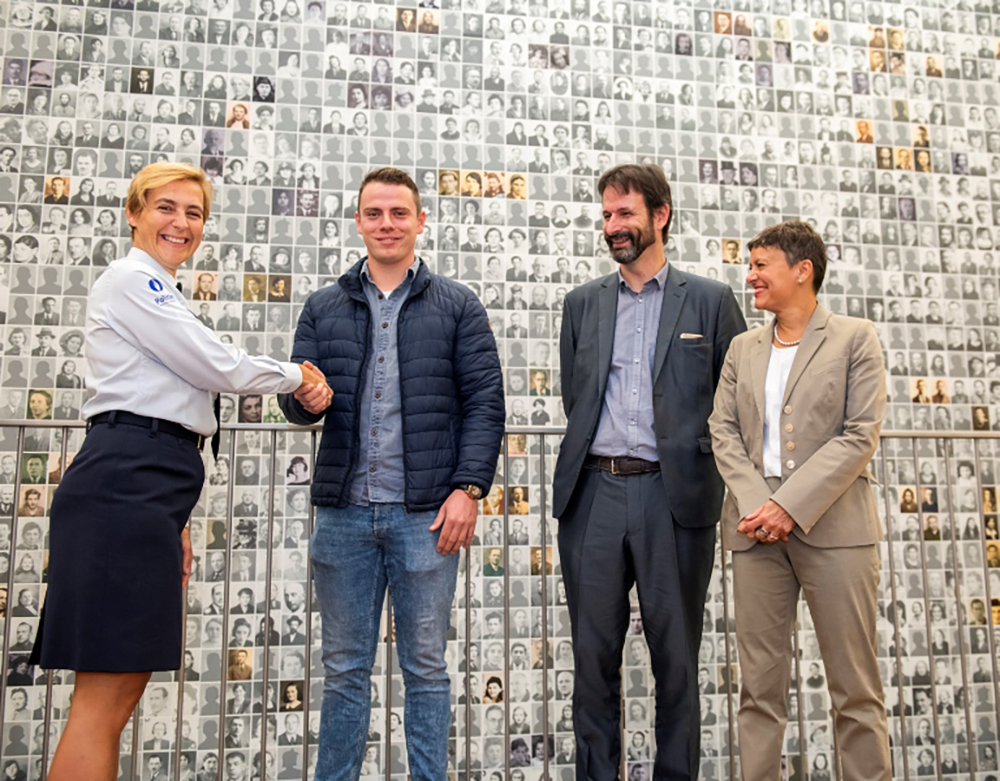
As the 10,000th participant on the ‘Holocaust, Police and Human Rights’ training course since it was first introduced in 2014, 20-year-old Selm from Oudenaarde was given an extra special welcome.
 dav
dav
Holocaust expert Dieter Pohl gave a talk entitled ‘What we know and what we don’t know about the history of the Holocaust’, organized jointly by Kazerne Dossin and the Institute of Jewish Studies.
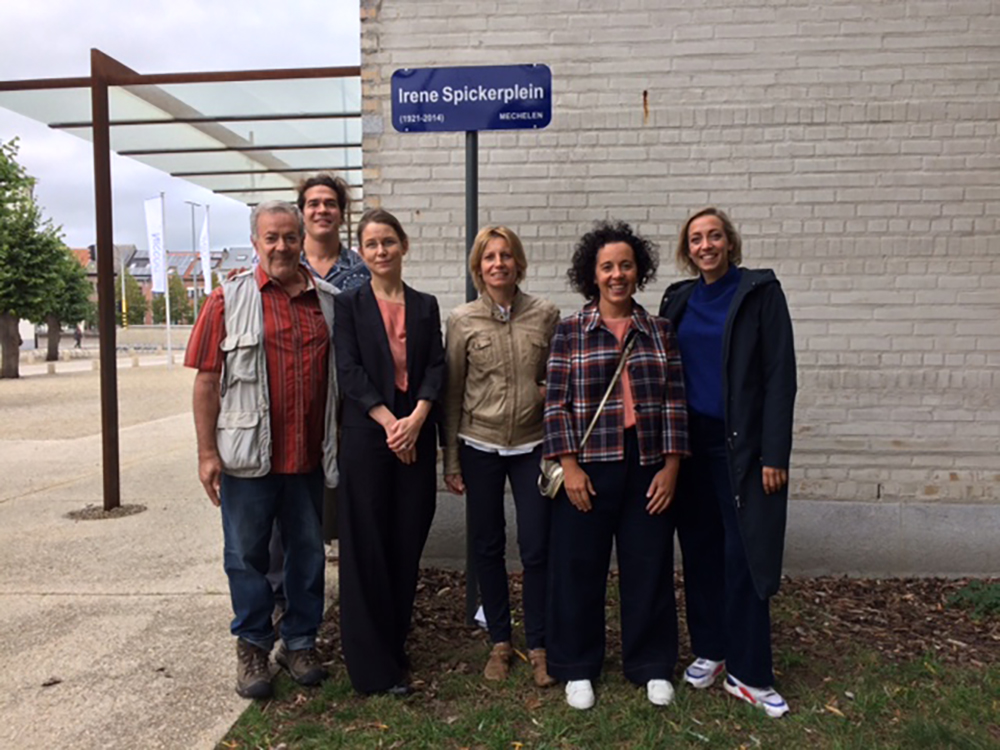
The square between the Museum and the Memorial was named the Irene Spickerplein in honour of Irene Spicker who was a Jewish artist interned in Dossin barracks. Her son and grandson unveiled the nameplate.
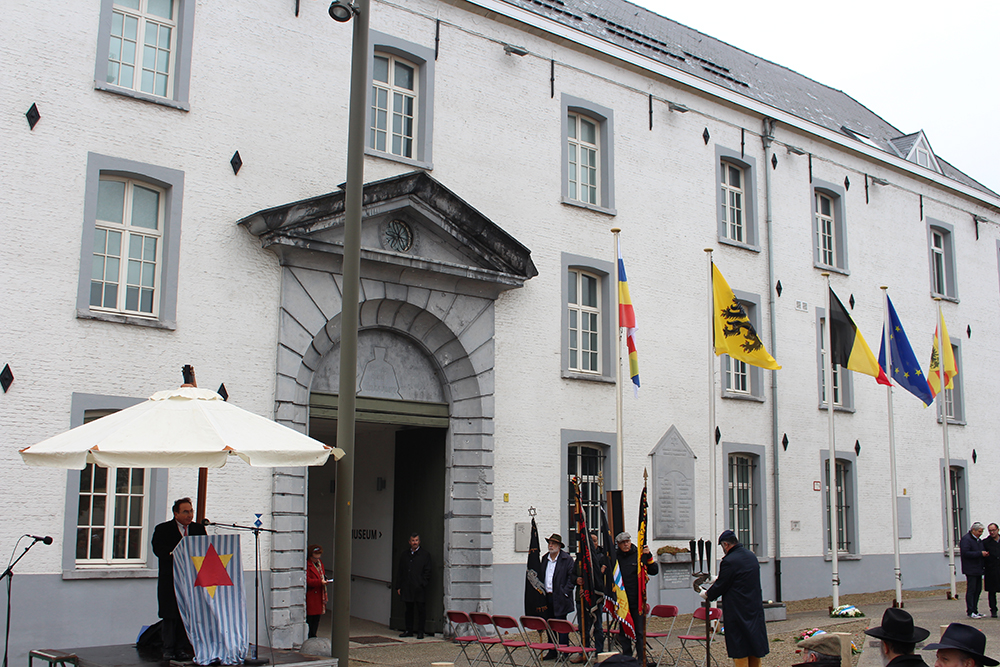
The 63rd pilgrimage to the former Dossin barracks took place on October 6th, marking the 77th anniversary of the beginning of the deportation of Jews, Roma and Sinti.

Polarization can lead to violence between groups, but sometimes it is necessary if headway is to be made. In collaboration with GO!, Kazerne Dossin organized the first open training session entitled ‘Wij of zij: omgaan met de dynamiek van polarisatie’ (We or they: dealing with the dynamics of polarization). The same day the network also presented its new ‘wij-zij’ website.
Read moreThe Quetzal Prize for Human Rights and Democracy in Guatemala was presented at Kazerne Dossin. This year the prize went to Bernardo Caal Xol, who campaigns tirelessly for impunity in Guatemala.
 (c) Guy Kleinblatt
(c) Guy Kleinblatt
 (c) Guy Kleinblatt
(c) Guy Kleinblatt
 (c) Guy Kleinblatt
(c) Guy Kleinblatt
 (c) Guy Kleinblatt
(c) Guy Kleinblatt
 (c) Guy Kleinblatt
(c) Guy Kleinblatt
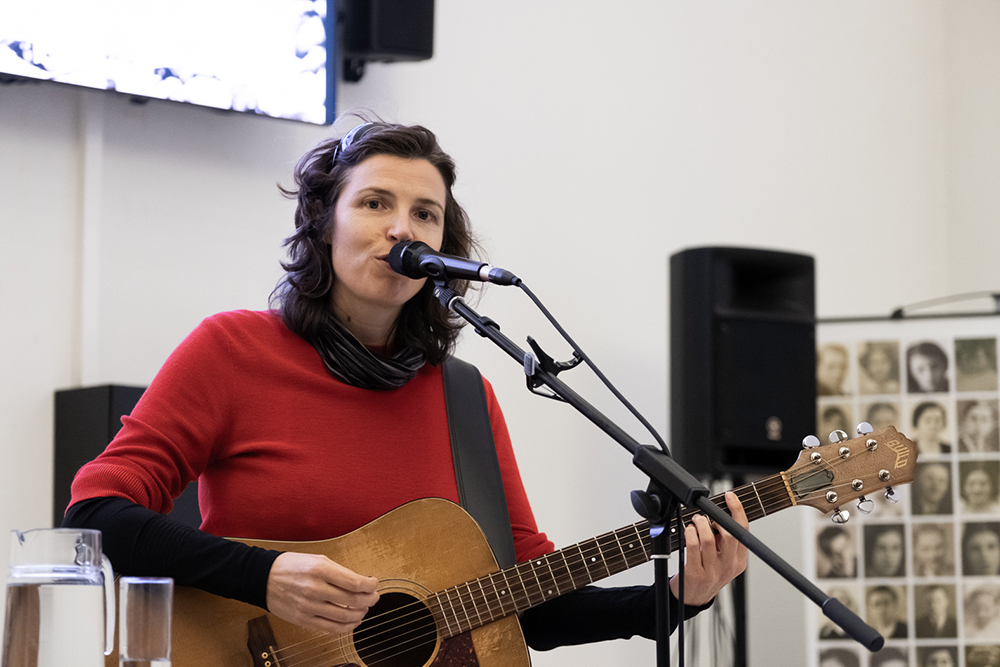 (c) Guy Kleinblatt
(c) Guy Kleinblatt
 (c) Guy Kleinblatt
(c) Guy Kleinblatt
 (c) Guy Kleinblatt
(c) Guy Kleinblatt
The auschwitz.camp exhibition was officially opened. Professor of Sociology of Crime (KULeuven) Stephan Parmentier delivered the keynote address. A panel discussion with Christophe Busch, Frederic Crahay and Hans Citroen followed. The guest exhibition ‘Exodus’ of photographs by photographer Hilde Braet opened that same evening.
Read more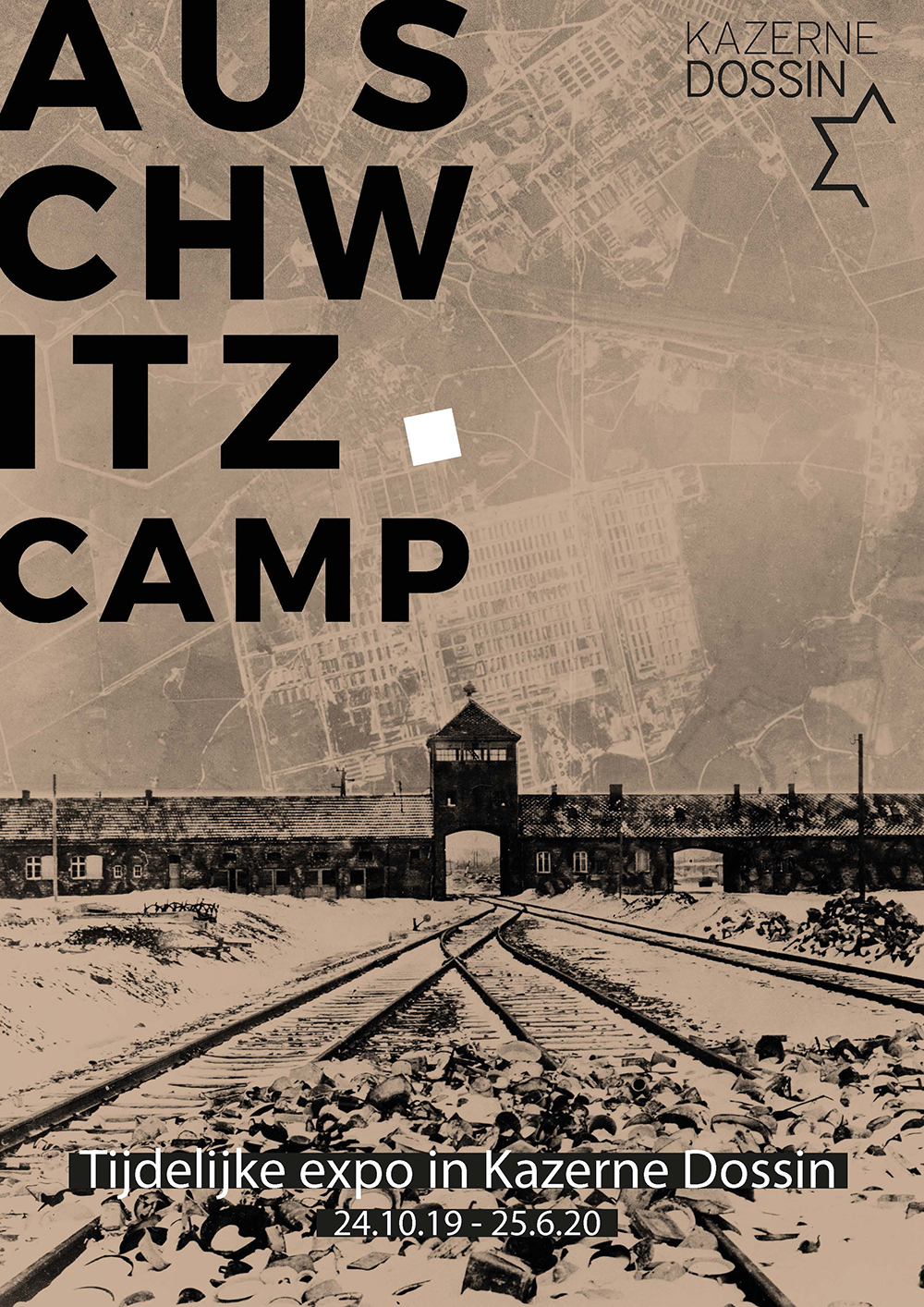
Temporary exhibition : auschwitz.camp
24.10.2019 - 25.06.2020Images of barbed wire, maltreatment and mass murder have made Auschwitz the symbol of the Holocaust. But behind the horror is a multi-layered story. How did a labour camp become an extermination camp with gas chambers? How did a mix of colonialism, racial beliefs and extermination politics lead to one of the most infamous episodes in recent history? Images, maps and objects show that the Interessengebiet Auschwitz was more than a camp. It was a Nazi empire in the making.
Read more
Guest exhibition : Exodus
25.10.2019 – 24.01.2020Photographer Hilde Braet visualized two stories, the stories of Charlotte and Esra. Though they differ in time and place, they have much in common. Theirs are stories about the destructive power of constantly having to flee. The now 95-year-old Charlotte Klipstein immigrated to Belgium just before the Second World War. To avoid deportation to Auschwitz, she had to go into hiding several times. Esra fled Afghanistan and eventually found herself in the Red Cross refugee centre in Belgium.
Read more
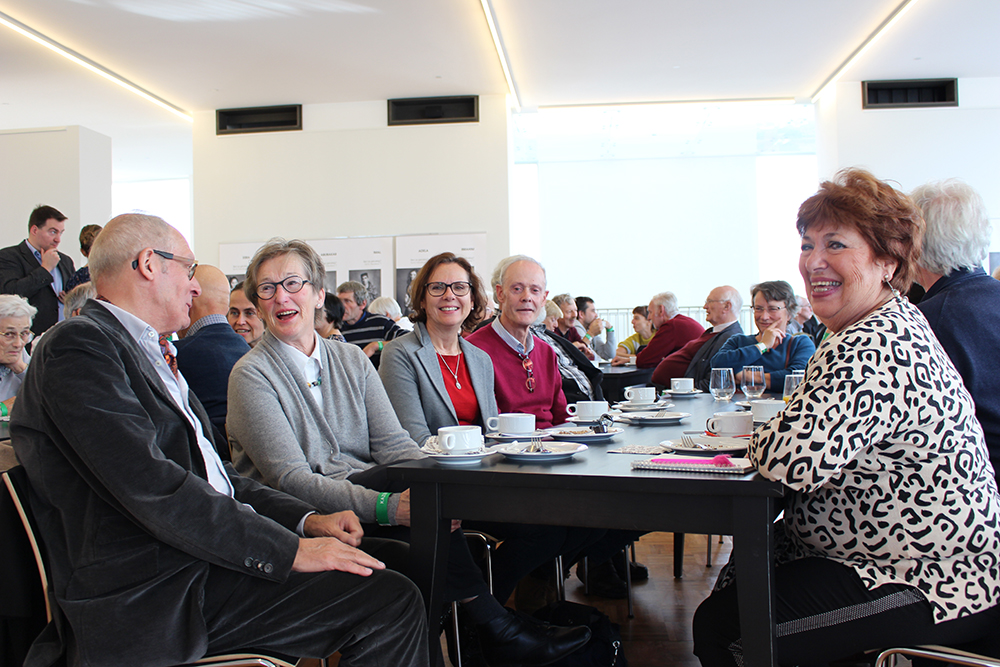

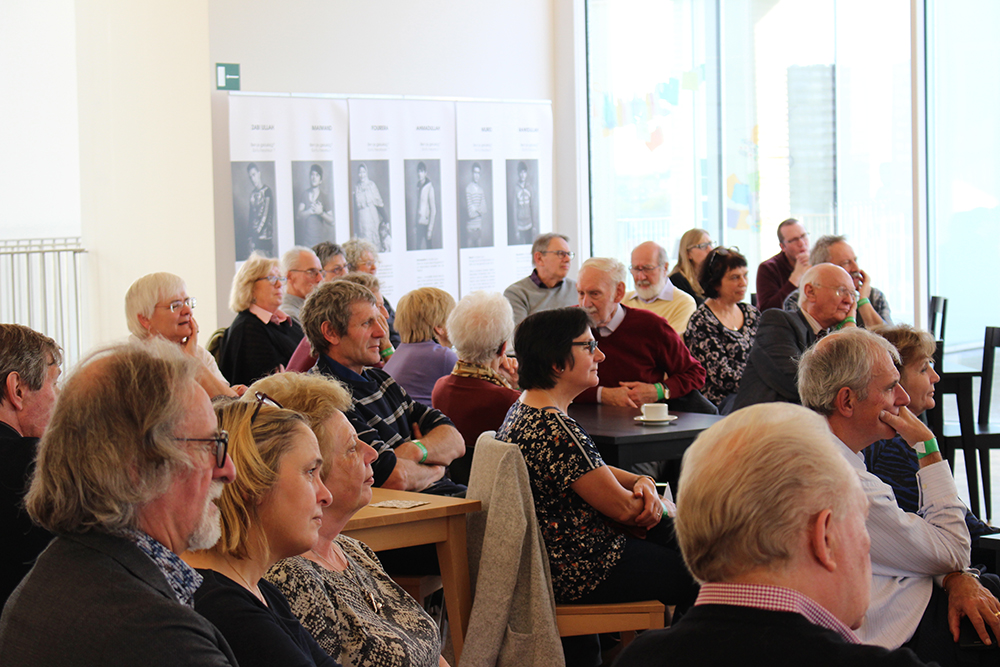
Our Friends and archive donors were invited to the first Friends’ Day to thank them for their support. They were given an exclusive viewing of the new special exhibition auschwitz.camp.
Historians Veerle Vanden Daelen and Frank Sebrechts were guests on the authors’ stage ‘Antwerp during the Second World War’ at Antwerp Book Fair.


History has never been so burningly topical and that is precisely the point author and theatre-maker Kurt Defrancq wanted to make with his production, ‘De Binnenzak van de ziel’ (The inside pocket of the soul). Several classes of schoolchildren were invited to Kazerne Dossin for a preview.
During the study day ‘La discrimination – comprendre, prévenir et réagir’ (Discrimination – understand, prevent and react), Kazerne Dossin presented numerous effective educational tools for dealing with discrimination in the classroom.
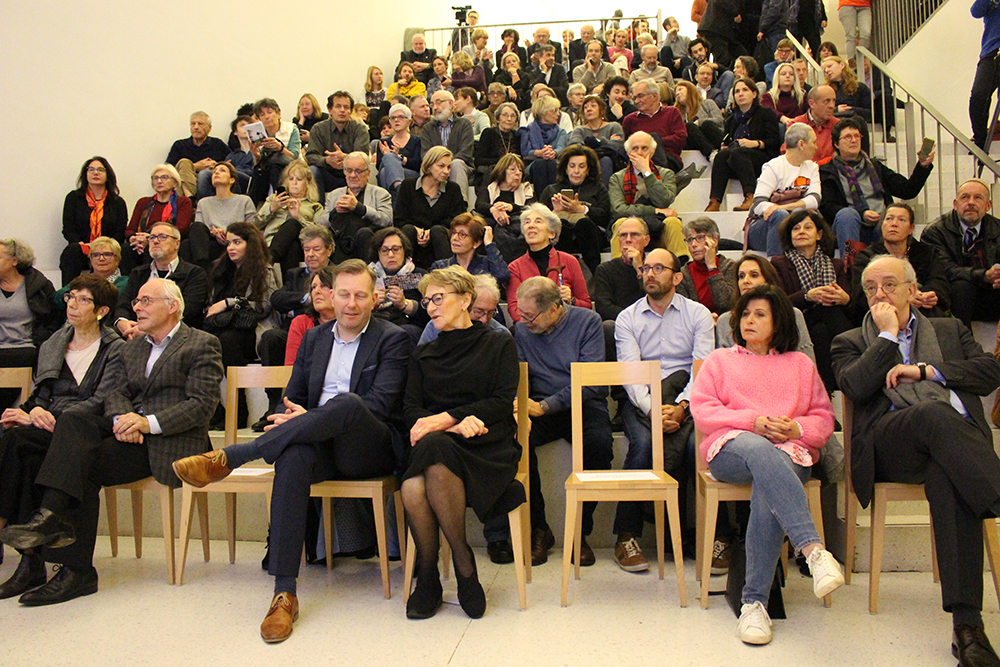



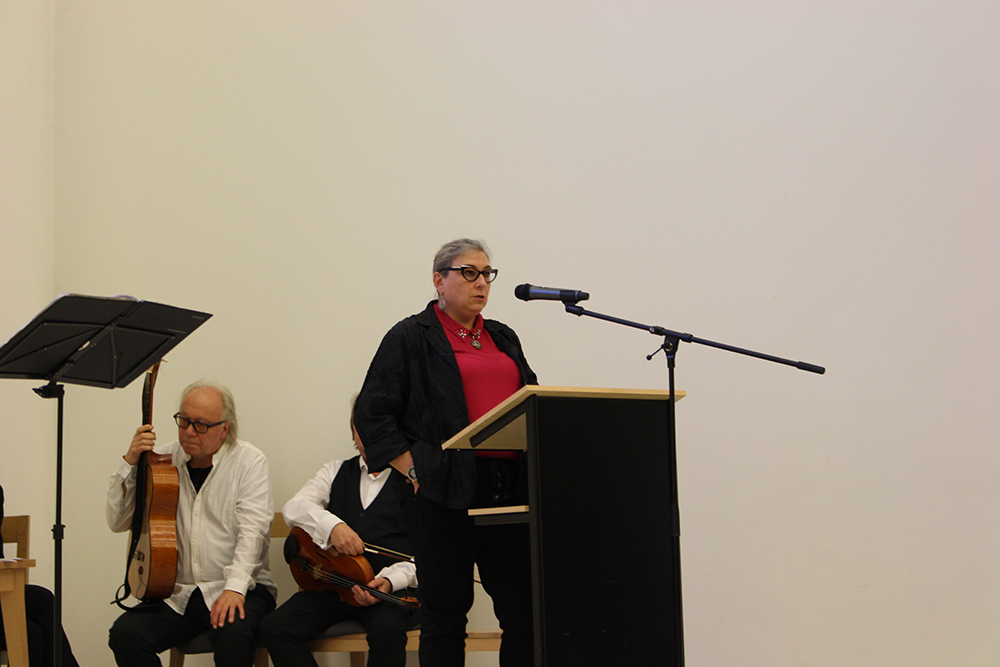


At the annual portrait ceremony, more than 220 new portraits were added to the impressive wall of portraits. David Van Turnhout recounted how he had tracked down two portraits of family members.
Photographer Hilde Braet talked to 95-year-old Charlotte Klipstein, who went into hiding and managed to avoid deportation to Auschwitz. Inspired by the ‘Exodus’ exhibition, she spoke about fleeing then and now.
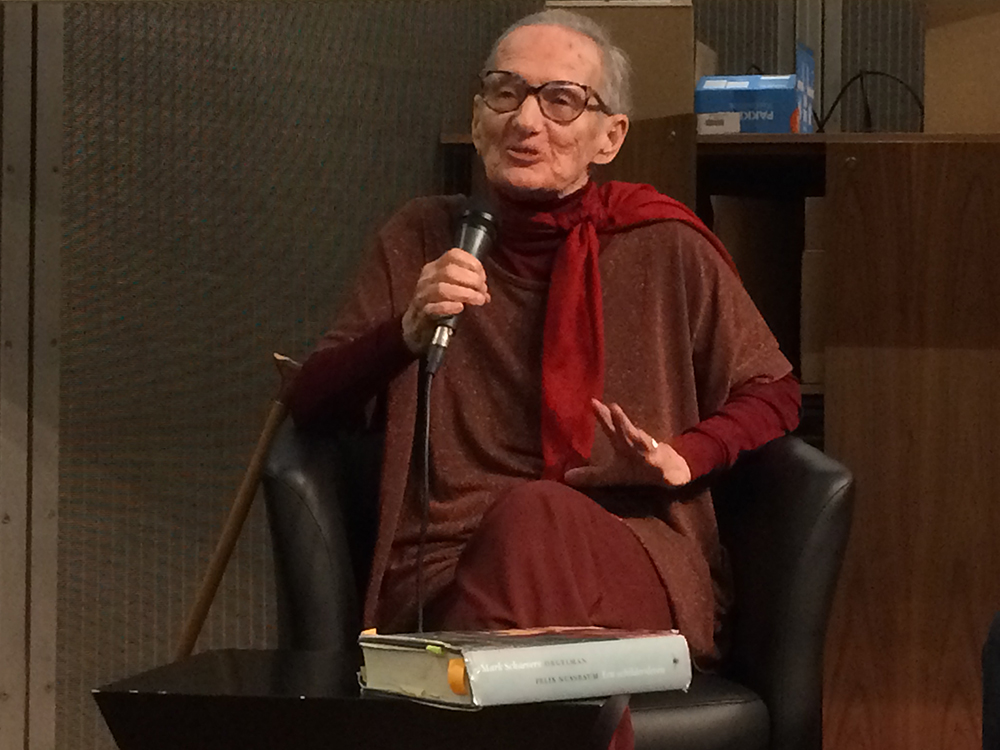


Kazerne Dossin showed the documentary ‘Felix Nussbaum’. Afterwards, film-maker Lydia Chagoll and writer Mark Schaevers discussed artist Felix Nussbaum’s impressive oeuvre.

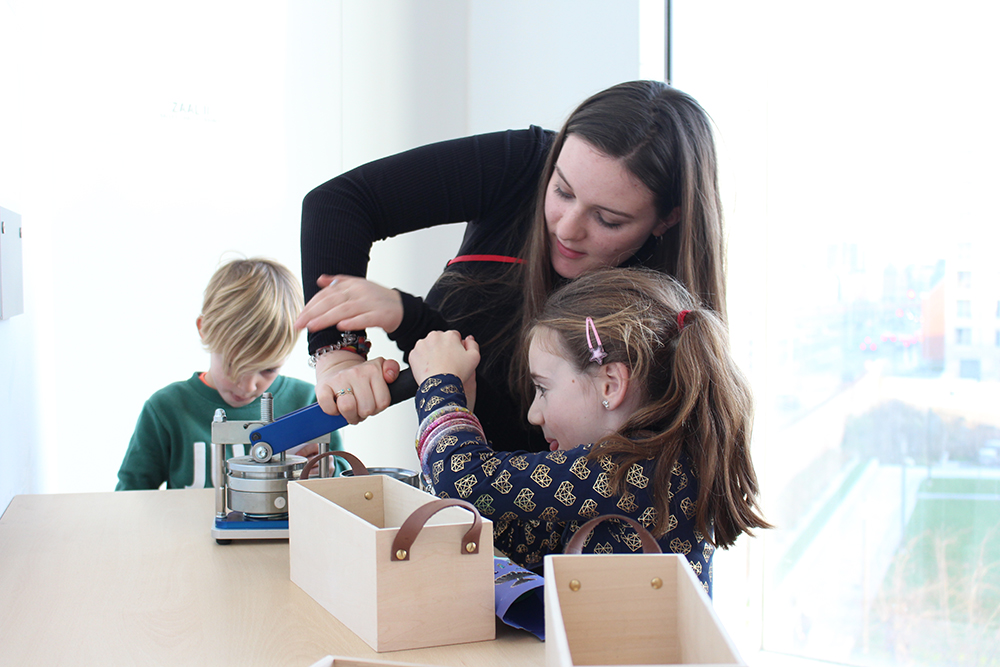
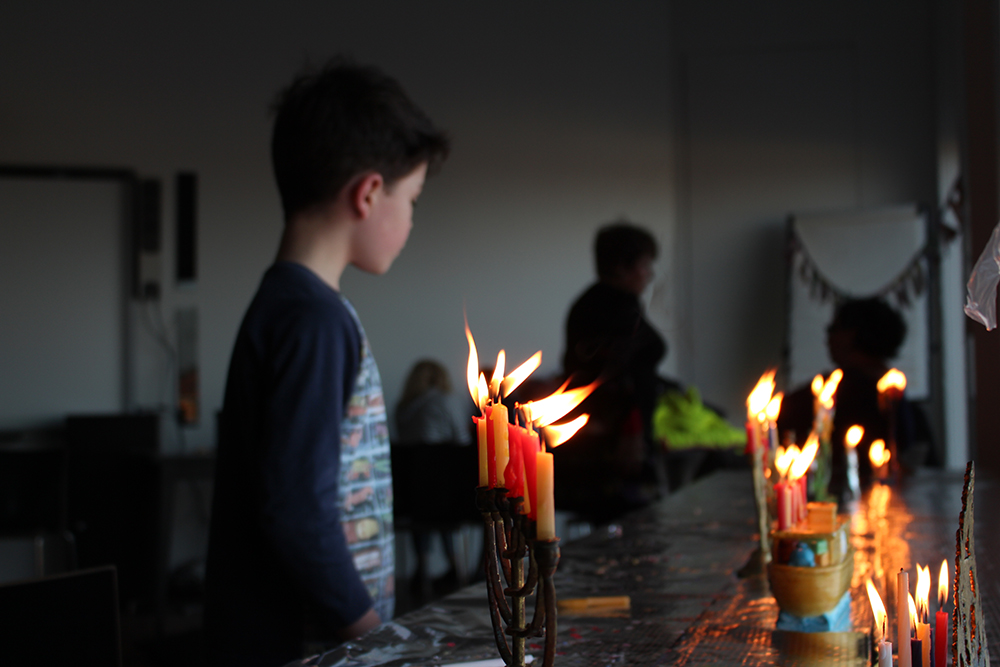
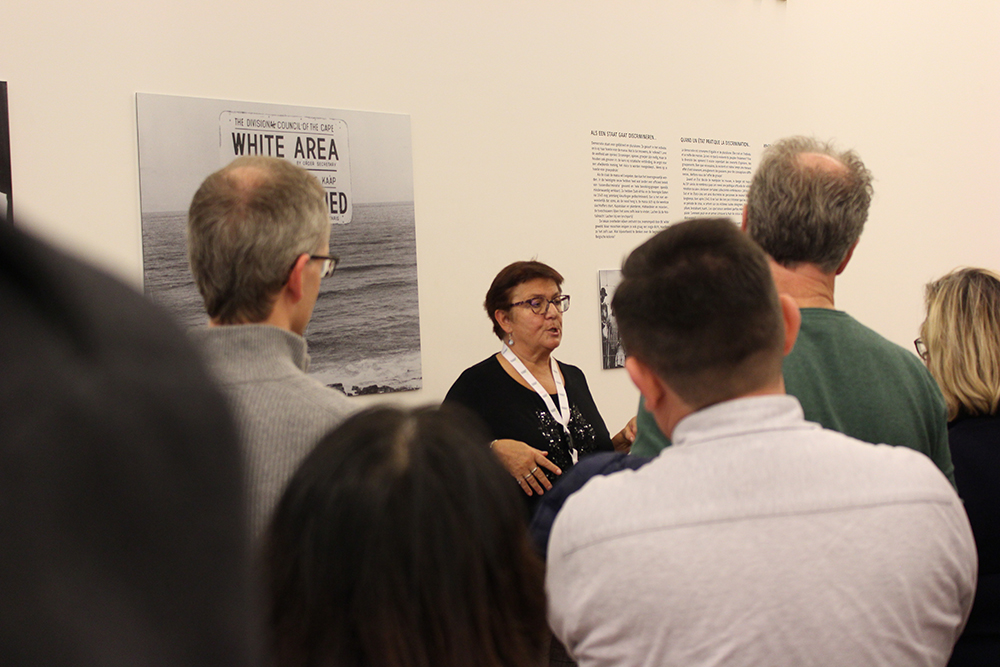


On the annual Day of the Public, the museum was open free of charge. Visitors were able to view the permanent exhibition and the special exhibition ‘auschwitz.camp‘, and enjoy numerous other activities too. We welcomed no fewer than 905 visitors.
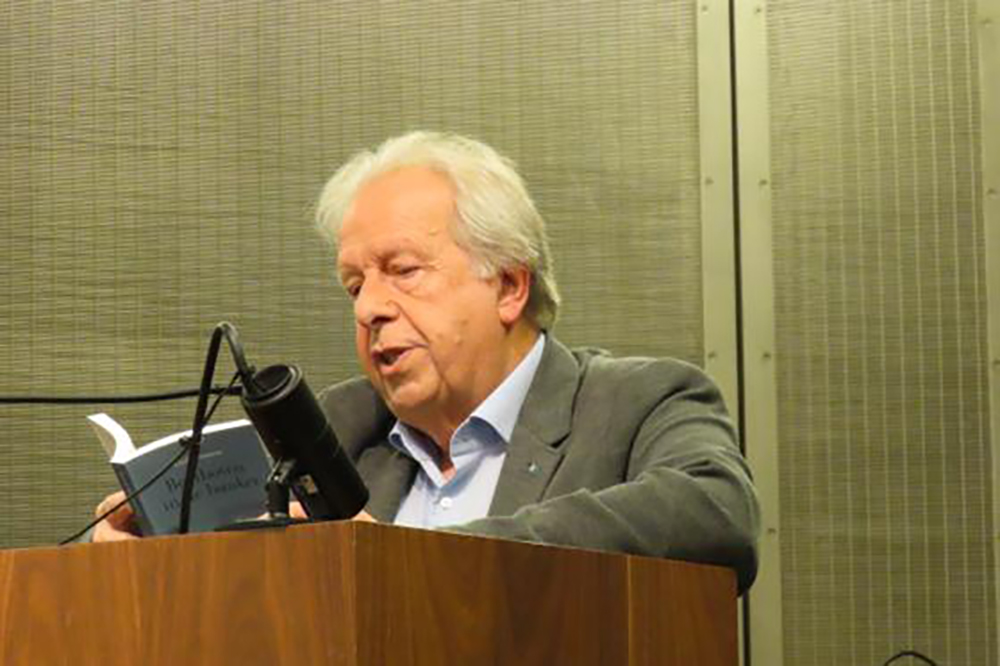

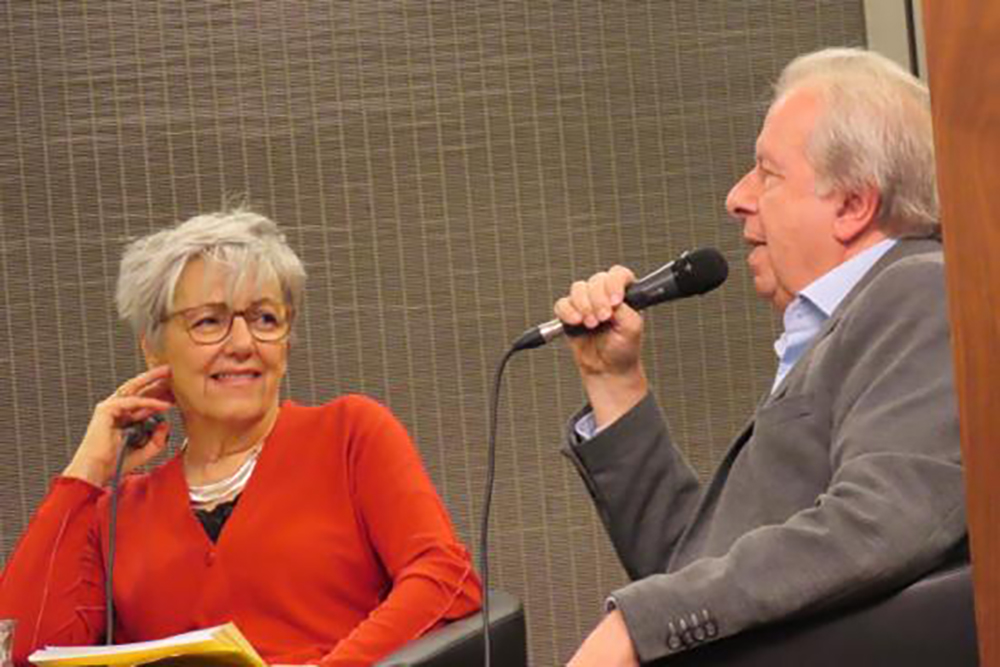

The Belgian publisher’s EPO, presenter Frieda Van Wijck and author Fred Brouwers presented the book ‘Beethoven in de bunker’, about the Nazis’ remarkable relationship with classical music.
Public mediation
Talks, lectures and training sessions for groups
Staff members gave lectures, instruction and training sessions to groups of students, pupils, professionals and socio-cultural organizations on a whole range of subjects:
- Polarisation43
- A demonic transition15
- From bystander to upstander4
- Holocaust and Remembrance education3
- The Dossin barracks3
- Jewish life and antisemitism2
- Auschwitz1
- Archiving1
- Museum operations2

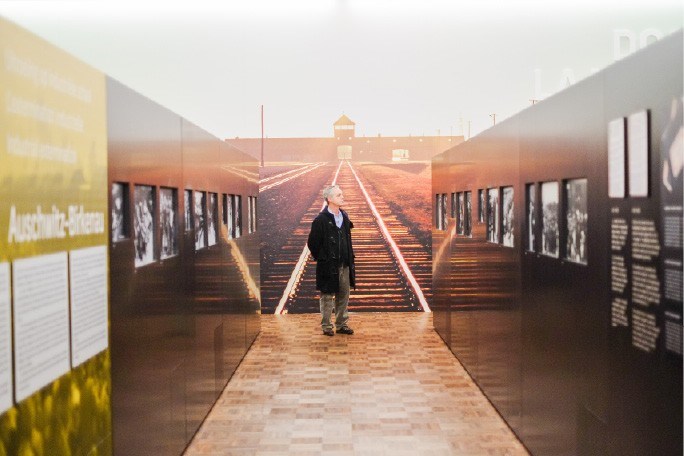
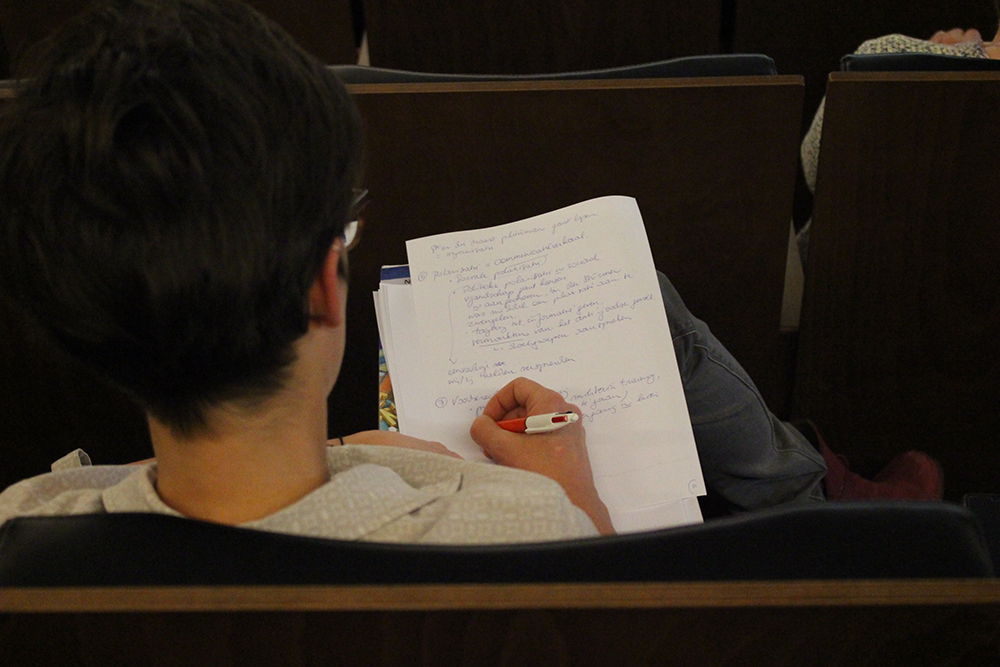
Guiding
Tours led by our authoritative and motivated guides continued in 2019. As always, our guides were able to count on the support of their monitoring team. That team follows guided tours on a regular basis, updates the guide’s competency profile, has evaluation discussions with the guides, keeps them informed by means of the guides’ platform and newsletters and organizes get-togethers. For example, on March 14th our guides followed a training session on polarization which included a keynote speech by Dirk Van Duppen, on April 29th an information session on the model of former Research Professor in Genocide Studies and Prevention Gregory Stanton and on October 14th a session on the Inzovu Curve. On June 20th we erected our annual summer marquee.
“I usually visit museums without a guide, but I’m so glad I was with a guide this time. The stories behind a photograph, the overall picture, etc. reduced me to silence.
Definitely worth a visit.” – Steven

Training session: ‘Holocaust, Police and Human Rights’
In 2019 the Holocaust, Police and Human Rights (HPM in Dutch) project celebrated its fifth year and welcomed its 10,000th participant. No fewer than 2,390 members of the integrated police attended the HPM training day, thereby exceeding the record of 2,000 participants per year for the first time since the start of the project. This brings the total number of participants since the start of the project to 10,778.
To meet the demand from the various police zones and departments of the federal police, a further 13 coaches were recruited to the French-speaking network. They successfully completed their five-day training as coaches and have since started leading training sessions.
Read moreRETHINK project
The RETHINK project (Remembrance Education for THINKing critically) aims to facilitate the dissemination of programmes that promote tolerance and respect towards diversity and also to develop media literacy and critical thinking skills. The seven partners involved in this project believe that by linking past and present, remembrance education sheds light on the historical significance of polarized identities, provides insight into European history and tools to combat intolerance. A freely accessible, searchable database provides an overview of educational practices that combat prejudices and promote the values of tolerance and diversity in Europe.
In 2019 RETHINK partners selected good practices that provide educational opportunities for developing critical thinking, self-criticism, self-evaluation and self-reflection. These practices were trialed by the partners in various contexts in eight European countries. The results of this remarkable attempt at up-scaling were compiled in a ‘Teacher’s Guide’, which gives teachers a toehold for tackling challenges they encounter when teaching remembrance education. The project will round off with a final conference in Brussels in 2020.
Read more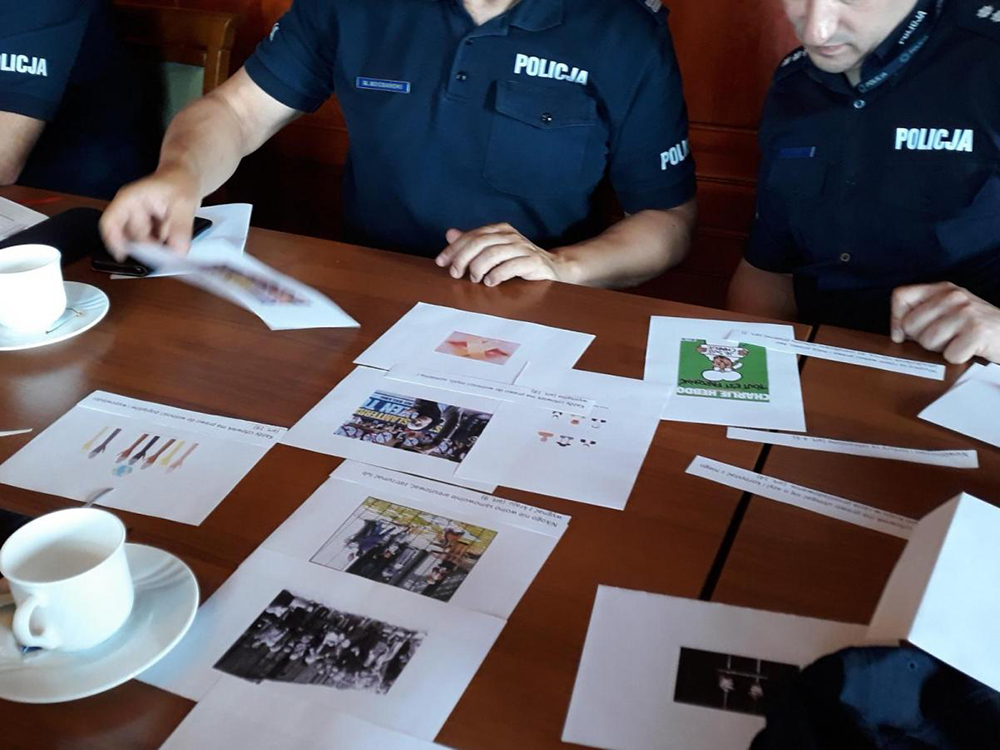
Project HHEINA
The international educational HHEINA project gathered momentum in 2019. Together Kazerne Dossin, the POLIN Museum of the History of Polish Jews and the Anne Frank Foundation compiled six manuals for police and six manuals for teachers on the subject of dealing with discrimination. The manuals contain a practical step-by-step plan, worksheets and various didactic practices. To circulate the manuals as widely as possible, Train the Trainer days (TOT) were organized for both target groups – police and teachers. At the TOT days all the manuals were presented and trialled so that the participants themselves could set to work afterwards. The police training sessions were held jointly with members of the Dutch police force in April and May. The first TOT day for teachers was organized in April together with the Anne Frank Foundation and Dutch teachers. In November we used the manuals to train French-speaking teachers during ‘La journée des profs’ at Kazerne Dossin. Finally, the manuals were distributed by TOT alumni during 17 classes organized by them. 400 people took part.
In December a final, two-day seminar was held at the POLIN Museum in Warsaw, where the three partners presented the project website. The participants – most of them teachers and police officers from three countries, but also representatives of other institutions involved in anti-discrimination education (from Poland, Germany, Hungary, Lithuania and Slovakia) – were given the chance to share their experiences and to compare situations, methods, challenges and opportunities in various European countries.
Read more
Polarization project
The Polarization project gathered momentum in 2019. A project worker was appointed and on October 22nd the ‘we-they’ network that Kazerne Dossin developed around this theme launched its online knowledge platform wij-zij.be. The site features depolarization strategies, tools, tips and scientific research. Short films and articles inspire visitors, prompt them to reflect on polarization and offer them a professional holdfast.
Polarization training also made great strides. The network organized 43 polarization sessions for approximately 1,200 participants and managed to reach a very diverse audience: from secondary schools, universities and socio-cultural organizations to local branches of political parties, trade unions and social services from towns and municipalities. For the first time we also held ‘open training sessions’ in-house at Kazerne Dossin. 122 professionals enrolled for the two sessions. The success of our training offering and the good mix of participants reflect the scale of the need for a cogent response to polarization problems across the very diverse social strata.
Read moreTraining session: ‘Polarization: a threat or an opportunity of a lifetime for the police?’
At the request of the General Commissioner and the General Directorate of Resource Management and Information, a one-day training session on dealing with polarization was developed for the integrated police. It was designed to give participants insight into the mechanism and to help them recognize polarization in society and in the police force. Participants were then asked to apply the paradigm to a number of case studies.
After several trial sessions and a positive evaluation, from September one Dutch and one French-language session were held each month in approved police schools. A total of 114 police officers attended these eight sessions. A spin-off of the training sessions was to reinforce cooperation between Kazerne Dossin and the Federal Police’s Diversity Unit.
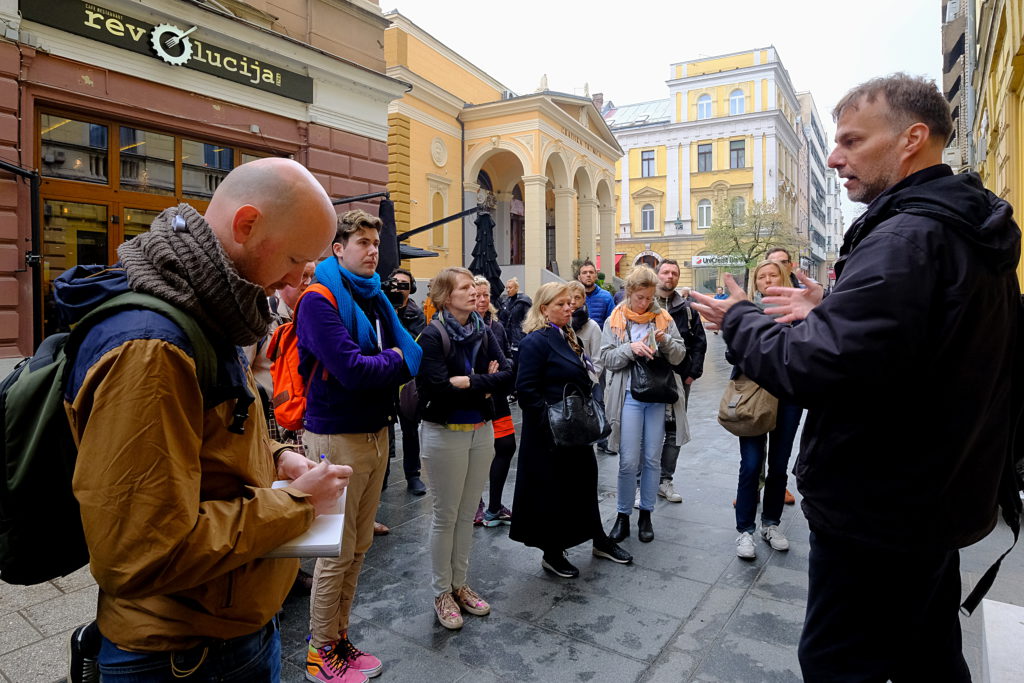
Balkan trip
For the second time Kazerne Dossin organized a study trip to Bosnia-Herzegovina for teachers and others who spread the Kazerne Dossin message. After a preparatory session (on March 20th), on April 8th they headed for the Balkans. Places like Sarajevo, Mostar, Prijedor and of course Srebrenica made a deep impression on the 15 participants during their week-long stay. The debriefing and evaluation sessions on June 6th provided us with invaluable input for the next trip.
For the most part, I got answers to my questions without my asking them explicitly, because that was never my intention. The experiences there, the discussions with eye-witnesses and the literature provided along the way gave me the necessary understanding to find the missing answers one day. (Björn)
What’s new, propaganda, conspiracy and fake news
Kazerne Dossin and Mediawijs jointly developed material to educate young people about media literacy. Under the name ‘What’s new?’, we worked on a guided tour relating to propaganda then and now and on a workshop designed to give young people the necessary tools to become more resilient to conspiracy theories. The workshop and the materials were tried out and on September 25th teachers could sign up for a webinar on these themes.
Memory Lab
Kazerne Dossin took part in Memory Lab, a Trans-European Exchange Platform on History and Remembrance. This edition of the annual study trip/workshop, which was held in Albania from September 23rd to 30th, explored the period of Communist terror under Enver Hoxha. The participants, who represented historical museums, memory sites, etc., looked at how Albania is dealing with the sensitive issue of its Communist past and compared their findings to similar experiences in other parts of Europe.

Bijzonder Comité voor Herinneringseducatie (BCH) and Conseil de la Transmission de la Mémoire
2019 was another very busy year for the Bijzonder Comité voor Herinneringseducatie or BCH (Special Committee for Remembrance Education). The year was characterized by numerous innovations in the Flemish education system, including the introduction of the new final attainment levels for the first grade A and B streams, which posed a number of challenges for teachers. At the same time we spotted many opportunities for innovation in schools, including in the field of remembrance education and global citizenship. To familiarize teachers with the new final attainment levels and inspire them with ideas for lessons, the BCH organized a successful forum day in association with Kruit.
The BCH also did further work on its new website, which it hopes will better support teachers in the future both in terms of content and didactically when teaching (emotionally-charged) historical themes that influence the collective memory, such as the Great War, the Holocaust and Belgium’s colonial history. A cooperation project with the Archief voor Onderwijs (Archive for Education) was also set up to create a project site on remembrance education based on audio-visual archive material. Furthermore, the BCH gave several talks and training sessions and the network regularly lent its support to teachers and organizations on external projects. On the French-speaking side, Kazerne Dossin has a seat on the ‘Conseil de la Transmission de la Mémoire de la Fédération Wallonie-Bruxelles’.
Read more
Museum shop
The museum shop continued to expand its stock with new publications. In 2019 turnover was up by 55% compared to 2018. Furthermore, five book presentations were organized at Kazerne Dossin in association with several publishing houses.
External events
Its noteworthy architecture and central location have made Kazerne Dossin an increasingly attractive venue for external events. In 2019 rooms were hired by companies and organizations for meetings, workshops, study days, etc. on 70 occasions, i.e. almost double the number of the previous year. Kazerne Dossin also looked at how it might work with Het Predikheren for MICE events (meetings, incentives, conferences and exhibitions). Het Predikheren, which is next to the museum, opened in 2019 and is the new city library.
Read moreCollections & research
Image Archive
In 2019, 62 new collections were added to the Image Archive. These were not only recent acquisitions, but also additions to older gifts which are now accessible in their entirety on the Image Archive. Together the 62 additional collections run to 5,772 scans of thousands of documents, photographs, objects, precious printed matter, etc. This took the number of available images up to 1,021,772. In 2019 a total of 11,257 people made use of the Image Archive, either accessing it from home or in the reading room at Kazerne Dossin or at partner institutions.
Read moreDigitization
Kazerne Dossin relies on a team of enthusiastic volunteers to digitize its collections. They scan not only recent acquisitions, but also digitize the research files gathered by researcher, interviewer and founder of Les Compagnons de la Mémoire, Johannes Blum. Since 1994 Blum has interviewed more than 1,000 survivors of the Second World War and put together a file containing newspaper cuttings, historical photographs, obituaries, etc. for each survivor. As well as digitizing work, the volunteers also help manage the library and make collections accessible by, for example, completing name indexes of victims.
Interviews with the last survivors
Kazerne Dossin has set itself the challenge of recording the stories of as many survivors as possible. The interview project launched in 2018 was continued in 2019. A total of nine survivors of the Holocaust in Belgium or their family members were interviewed. These sort of conversations are often planned after the initial contact is established with a view to donating documents, photographs or objects. The project is managed by volunteer Betty Swaab, who we wish to thank.
Collaboration with UA on restoration of Spicker paintings
Cooperation between the Collections & Research team and the Conservation-Restoration course at the University of Antwerp continued in 2019. In UA’s painting studio, students studied five authentic works from the Kazerne Dossin collection painted by Irene Spicker-Awret. They were produced during the war, some even during Irene’s internment in Dossin barracks, and are very fragile. The students made reproductions which can be exhibited. They also restored the five originals with their preservation in mind.

Deportations 75 years on
In 2017 Kazerne Dossin launched the ‘Deportations 75 years on’ series. The date of departure of each convoy from Dossin barracks was commemorated 75 years later with the publication of biographies of the deportees. In 2019, 12 stories appeared on the website, including the history of the special trains from Mechelen to Vittel and Bergen-Belsen, the trains carrying Roma and Sinti, and the biography of Felix Nussbaum (deportation convoy XXVI). The stories struck a chord with the general public.
Read moreKinderen van de Holocaust
Following on from ‘Children of the Collaboration’, ‘Children of the Colonization’ and ‘Children of the Resistance’, in 2019 the Canvas television channel and Kazerne Dossin jointly started researching the series ‘Children of the Holocaust’. After a first brainstorming session, the Collections & Research team went in search of relevant witnesses, produced information sheets about them and put the production team in touch with them. At the request of Canvas, the Collections & Research team read through the connected texts and cast a critical eye over the first version of the instalments.
Remodelled Memorial
In 2019 the Collections & Research team made preparations for the new Memorial, due to open at the beginning of 2020. Working with scenographer Antoine Goldschmidt, members of the team chose relevant photographs and documents from KD’s own archive collection to illustrate the story of Dossin barracks in the period 1942-44. Objects were prepared for positioning in the display cases, accompanying captions and introductory texts were written and messages on letters thrown out of the deportation trains recorded.
Talks and colloquia
In 2019 the Collections & Research team delivered numerous lectures on a range of subjects: persecution, the liberation of Dossin barracks, going into hiding, topical themes like anti-Semitism, negationism and human rights. Dr Laurence Schram delivered a lecture at the Université Libre de Bruxelles and appeared on television several times. At the invitation of the Belgian ambassador to Israel and the B’nai B’rith World Center, Kazerne Dossin archivist Dorien Styven gave a talk about the Committee for the Protection of Jews (CDJ/JVD). Furthermore, members of staff took part in colloquia organized by institutions such as the Gedenkstätte Wolfenbüttel and the Mémorial de la Shoah in Paris. With Wolfgang Schellenbacher from the EHRI (European Holocaust Research Infrastructure), Veerle Vanden Daelen organized a workshop about the EHRI at the Lessons & Legacies conference in Munich. Earlier that year Veerle Vanden Daelen also gave a presentation of the EHRI at a research conference at the Mémorial de la Shoah Holocaust museum in Paris. Dorien Styven and Veerle Vanden Daelen jointly presented Kazerne Dossin and Migration at the annual meeting of the Association of European Migration Institutions (AEMI), which in 2019 was held in Antwerp. At the annual Contact Day arranged by the Institute of Jewish Studies, Veerle Vanden Daelen gave a presentation on orthodox survivors and allies in Antwerp immediately after the liberation, a timely prelude to the liberation commemorations. Veerle Vanden Daelen is also a member of the City of Antwerp’s scientific advisory body for the commemoration of WWII.

Left behind
In 1942 the occupier rounded up 2,252 Jewish men in Belgium, most of them from Antwerp. They were taken to labour camps in Northern France where they worked as forced labour on the Atlantic Wall. Most of them were then deported to concentration camps and extermination centres where they died. Thanks to a generous gift from Mrs. Gaby Morris and her family, in 2019 Kazerne Dossin initiated a project about the Antwerp citizens among those forced labourers and the fate of their families left behind in Belgium. The Collections & Research team created a database about this group of victims, recorded their addresses and wrote the first biographies. The project will find its way to the general public in 2021.

European Holocaust Research Infrastructure (EHRI)
The European Holocaust Research Infrastructure has had another busy and eventful year. The second term of EHRI’s project financed by Europe was rounded off at the end of October and the next phase commenced almost immediately in December. Having started out as a project with temporary financing, EHRI is now well on its way to becoming a stable research infrastructure to which Kazerne Dossin is making an active contribution. The main activity of the EHRI is to make information about Holocaust archives accessible on a single online portal. Descriptions of Kazerne Dossin’s collections are part of this and ensure greater visibility of, and access to our archives in an international context.
International Holocaust Remembrance Alliance (IHRA)
In 2019 the International Holocaust Remembrance Alliance was chaired by Luxembourg. Veerle Vanden Daelen, who is an authority on the Holocaust and a member of the Belgian delegation to the IHRA, took part in the plenary meetings in Mondorf-les-Bains in Luxembourg at the beginning of June and helped prepare the Belgian delegation in Brussels for the plenary meeting in Luxembourg on December 4th. During the course of that meeting, the IHRA, in association with UNESCO, launched an updated version of its Recommendations for Teaching and Learning about the Holocaust, which is available online.
Cooperation with the National Archives of Belgium
In 2019 Kazerne Dossin identified and scanned 993 Aliens Police files about deportees, thereby also bringing to light scores of new photographs for the wall of portraits. This large number of new files is the result of a transferral by the Immigration Office (Dienst Vreemdelingenzaken) to the National Archives. The research centre also examined family links in the aliens files in a bid to track down further file numbers and documents. Kazerne Dossin was able to count on the help and advice of a National Archives archivist, who we wish to thank.
Digital Research Infrastructure for the Arts and Humanities (DARIAH)
In 2019 Kazerne Dossin was again a member of the DARIAH network (Digital Research Infrastructure for the Arts and Humanities). As a co-founder of DARIAH’s Sustainable Publishing of Metadata working group, one member of staff attended the annual meeting in Warsaw and together with the other chairs of working groups organized interim meetings and activities. The 2019 meeting revolved around the publication of Trust and Understanding: the value of metadata in a digitally joined-up world. The publication contains contributions presented on the study day on this theme organized by the working group in 2018.
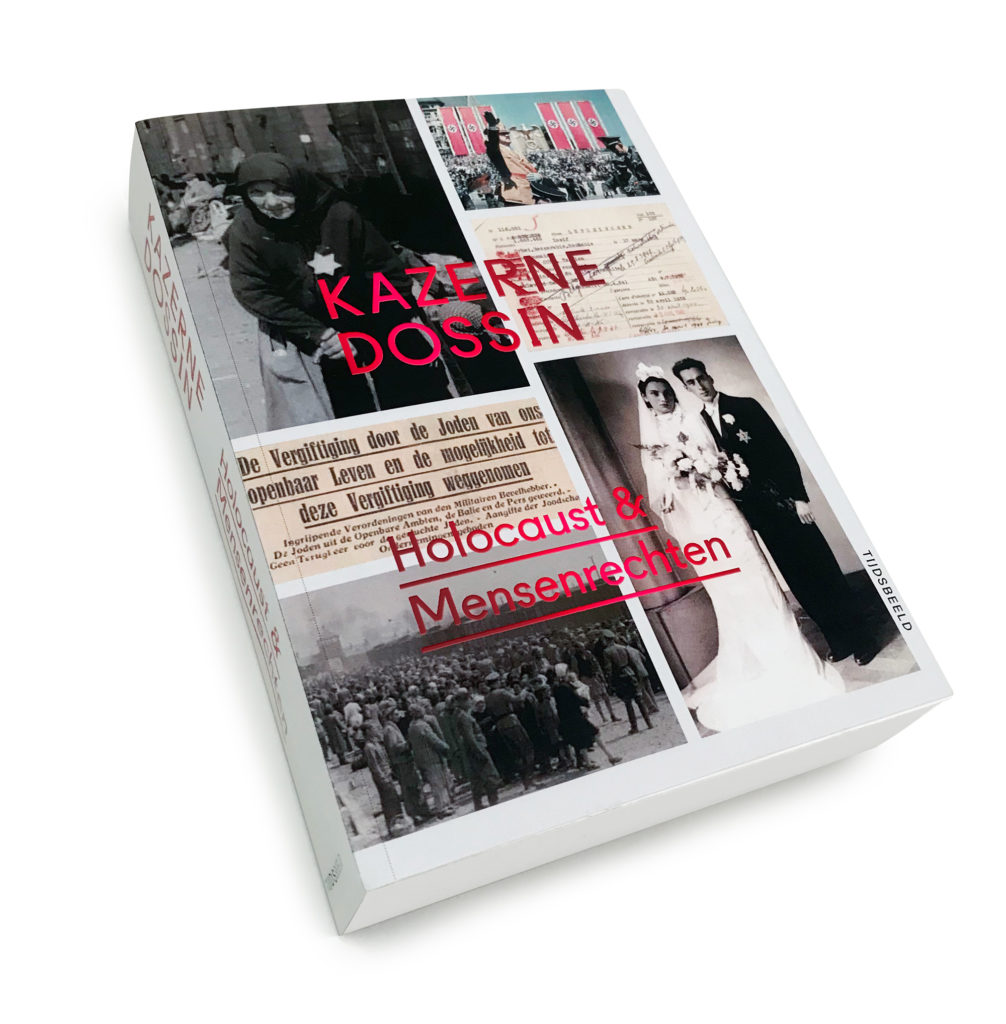
Kazerne Dossin: The museum in a book
75 years after the liberation, the publishing house of Tijdsbeeld & Pièce Montée presents ‘Kazerne Dossin: Holocaust and human rights’ (in Dutch), thereby offering a comprehensive overview of the museum in book format. This reference work contains more than 700 photos and documents and is the result of years of historical research by the Kazerne Dossin scientific team.
Read moreCollaboration with USHMM
In January 2019 Kazerne Dossin and the United States Holocaust Memorial Museum (USHMM) entered into an exchange agreement. Kazerne Dossin gave its American counterparts a copy of the most recent version of the portrait collection of faces of those deported from the Mechelen transit camp. In exchange, the USHMM digitized a number of its collections relating to the Holocaust in Belgium and gifted them to KD. For the most part, these were gifts from survivors or their families who emigrated to America after the war. The exchange reinforced the Kazerne Dossin-USHMM partnership.
Publications
Scientific publications
- Dorien Styven, “Une exploration comparative des Justes parmi les Nations en Belgique et aux Pays-Bas”, in: C. Bonafoux en O. Vallade (ed.), Survie des Juifs en Europe. Persécutés, sauveteurs, Justes, 2019, Lyon, pp. 130-147.
- Rolande Depoortere, Tom Gheldof, Dorien Styven en Johan Van der Eycken (eds.), Trust and Understanding: the value of metadata in a digitally joined-up world, Archief- en Bibliotheekwezen in België, nr. 106 (extra nummer), Brussel, 2019.
- Veerle Vanden Daelen, “Living Together in the ‘Yidishe Gas’: The Case of Antwerp”, Journal of Genocide Research (vol. 21: issue 3, 2019): 436-455, theme issue: “Microcosms of the Holocaust: Exploring New Venues into Small-Scale Research of the Holocaust”, DOI: 10.1080/14623528.2019.1632022
- Laure Hobson Faure and Veerle Vanden Daelen, “Imported from the United States? The Centralization of Private Jewish Welfare after the Holocaust: The Cases of Belgium and France”, in: Avinoam Patt, Atina Grossmann, Lindag G. Levi and Maud S. Mandel (eds)., The JDC at 100: A Century of Humanitarianism. Detroit: Wayne State University Press (2019): 279-313.
- Veerle Vanden Daelen, “Antwerpia, 1930-2018”, in: Marcin Wodziński, Chasydyzm: Atlas Historyczny (Kraków/Budapeszt/Syrakuzy, Wydawnictwo Austeria), 2019: 205-209.
- Veerle Vanden Daelen, “Data Sharing, Holocaust Documentation and the Digital Humanities: Introducing the European Holocaust Research Infrastructure (EHRI)”, Umanistica Digitale, theme issue “Data Sharing, Holocaust Documentation and the Digital Humanities: Best Practices, Case Studies and Benefits”, 4 (2019)
- Giles Bennett & Veerle Vanden Daelen, “The European Holocaust Research Infrastructure (EHRI): Taking Stock”, in: Frank Bajohr & Dieter Pohl (eds)., Right-Wing Politics and the Rise of Antisemitism in Europe 1935-1941 Göttingen: Wallstein Verlag/München: Institut für Zeitgeschichte – Zentrum für Holocaust-Studien (2019) 249-259 (European Holocaust Studies, vol.1).
Publications (general public)
- Veerle Vanden Daelen, Dorien Styven, Griet Blanckaert en Carolina van der Star, “Hoe historische en emotionele waarde bewaren? Samenwerking met onderwijs levert vruchten op“, in: FARO. Tijdschrift over cultureel erfgoed, 2019 (jg. 12), No. 4, pp. 18-21.
- Dorien Styven, “L’enfant caché-asbl, des réalisations remarquables”, in: Adolphe Nysenholc (ed.), L’enfant sauvé. De la cache au statut, Brussel, 2018, pp. 97-103.
- Laurence Schram, “Des enfants et des lois”, in : Adolphe Nysenholc (ed.), L’enfant sauvé. De la cache au statut, Brussel, 2018, pp. 31-41.
- Laurence Schram, “Recensie: Monique Heddebaut – Des Tsiganes vers Auschwitz. Le convoi Z du 15 janvier 1944”, in: Getuigen, Fondation Auschwitz, 2019.
- Laurence Schram, “Persécution des Juifs sous l’occupation allemande“, in: Belgium WWII, 2019.
- Laurence Schram, “Caserne Dossin, camp de rassemblement pour juifs et tsiganes“, in: Belgium WWII, 2019.
- Laurence Schram, “Etoile de David“, in: Belgium WWII, 2019.
- Dorien Styven, “Joods Verdedigingscomité“, in: Belgium WWII, 2019.
- Laurence Schram, “75 jaar geleden: het laatste Jodentransport vertrekt van Mechelen naar Auschwitz“, in: Dossier. Van D-Day tot V-Day, VRT News, blog contribution, July 31st 2019.
- Laurence Schram en Dorien Styven, “75 jaar geleden: de ultieme reddingsoperatie voor 600 Joodse kinderen in België“, in: Dossier. Van D-Day tot V-Day, VRT News, blog contribution, August 25th 2019.
- Veerle Vanden Daelen, “75 jaar geleden: Duitse Joden voor de vierde keer slachtoffer”, in: Dossier. Van D-Day tot V-Day, VRT News, blog contribution, September 28th 2019;
- Veerle Vanden Daelen, “75 jaar geleden: de Joodse kinderen, de toekomst na de Holocaust”, in: Dossier. Van D-Day tot V-Day, VRT News, blog contribution, October 6th 2019;
- Veerle Vanden Daelen, “75 jaar geleden: een Joodse bakker, bedenker van de ‘Antwerpse Handjes’, getuigt over de kazerne Dossin”, in: Dossier. Van D-Day tot V-Day, VRT News, blog contribution, November 30th 2019.
With thanks to
Kazerne Dossin is extremely grateful for the following gifts to the research centre:
Karny-Chamech bequest with thanks to Rosita Winkler-Gol, David Pelc bequest with thanks to Sara and Sonia Hailstone, Norbert Vos bequest, Marion Finkels-Kreith bequest with thanks to Judy Kreith, Cuba’s Forgotten Jewels bequest with thanks to Judy Kreith and Robin Truesdale, Rachel Souritz bequest with thanks to Paulette De Coninck and family, Steinhardt-Safier bequest with thanks to Ruhama Bonfil, bequest of circular letter with thanks to Dirk De Smet, Mona Verhage bequest, Manes Klinger bequest with thanks to Paul Larivière and daughter, Rachel Hakker bequest, Oscherowitz-Silberberg bequest, Braginski-Dikker bequest, Wolf-Schnitzer bequest with thanks to Ariel Malik, Jo Peeters bequest, Christiaan Peeters bequest, bequest of anti-Semitic pamphlets with thanks to Warre Verhaeghe, Jacob Rubinstein bequest, Betti Blaugrund bequest, Charlotte Leitersdorf bequest with thanks to Félicie Gruszow-Bloch and children, Elie Guy Francès bequest, Dr O. Bar-Moshe bequest, Hanna Rotschild bequest, Salomon Polak bequest with thanks to Bertha Meyer, Jean-Marie and Dora Cottyn bequest, Sarah Goldberg bequest with thanks to Simon and Michel Goldberg, Annie Sliwka bequest, Brigitte Jacobsberg bequest with thanks to Annie Sliwka, bequest of records holder Reichsarbeitsministerium with thanks to National Employment Office (Rijksdienst voor Arbeidsvoorziening, Antwerp entity), bequest of interrogation transcriptions Adolf Eichmann with thanks to Mémorial de la Shoah (Paris), Mr. Hercz bequest with thanks to Regina Sluszny, Fishel-Black bequest bequest with thanks to Melvyn Fishel, scroll of the Book of Esther bequest with thanks to Alice Spruyt, Roger Pauwels bequest with thanks to Jeannine Rocour,
Meisel-Goldstein bequest met dank aan Alain Guilitte, Borisewitz collection on loan with thanks to Muriel and Tania Klein and family, Henri Roanne alias Rosenblatt bequest, Flor Van Laer bequest, Patrick Verwerft bequest, Sarah Goldberg bequest with thanks to Piet Van Damme, bequest of violin from camp prisoner with thanks to Platon Flam and Roger-Charles Jacobs, Andriesse bequest with thanks to Walter and Martine De Schampheleire-Marneffe, Jean-Paul Denis bequest of research collection with thanks to Bernadette Fraselle, Gulden-Bruches bequest with thanks to Florence Acke, Charlotte Goldberszt bequest, Philippe Fuchsmann bequest, François Heymans bequest, Marie Szyf bequest, Anne and Carlo Christiaen-Van Kelst bequest and Walter Papen bequest.
Kazerne Dossin wishes to thank all the researchers, family members and friends of deportees who made photographs available for Kazerne Dossin’s wall of portraits.
Kazerne Dossin would like to thank the following for their gifts to the library:
Inge Boehnke, Bernard Brogniet, Michel Christiaens, Willy and Jeanne Courteaux-Soens (with thanks to the Hendrik Conscience Heritage Library), Bibliotheek Permeke (with thanks to Dirk De Vos), Mathieu Dirckx and family, Gilbert Furcage, Mr. Lesniki, Estella Mendes, Werner Pottier, Patricia Ramet, Simon Spiegelman, Joseph Van Boeckel, Veerle Vanden Daelen, Gerda Vandertaelen and Wim Verdyck.
Marketing & communication
Website, mailings and social media
In 2019 Kazerne Dossin attracted a record number of digital visitors. With 122,650 unique visitors and174,576 visits, www.kazernedossin.eu achieved 39% growth compared to 2018. On January 27th 2019, Kazerne Dossin launched kazernedossin.memorial, a website devoted to information about the Memorial and the research centre, but where users can also search for and commemorate victims online. That website recorded 7,345 visitors. In 2019 the annual printed report was exchanged for an online version, which can be viewed at annualreport.kazernedossin.eu. It was read by 643 people.
Kazerne Dossin managed to extend its reach by means of social media. With 199 posts on Facebook, our news appeared 50,483,518 times on the page of followers, likers and other interested parties. Messages and stories on the Instagram page inspired approximately 400 new followers.

Press
Kazerne Dossin was mentioned 618 times in the press, a 23% increase on the previous year. 61% of the coverage appeared online, 29% in regular newspapers and 10% on radio and television. The museum reached a total of 78.965.451 readers and viewers, equivalent to € 30.260.780 of media value. Highlights included the opening of the auschwitz.camp exhibition, guest exhibitions and the portrait celebration.
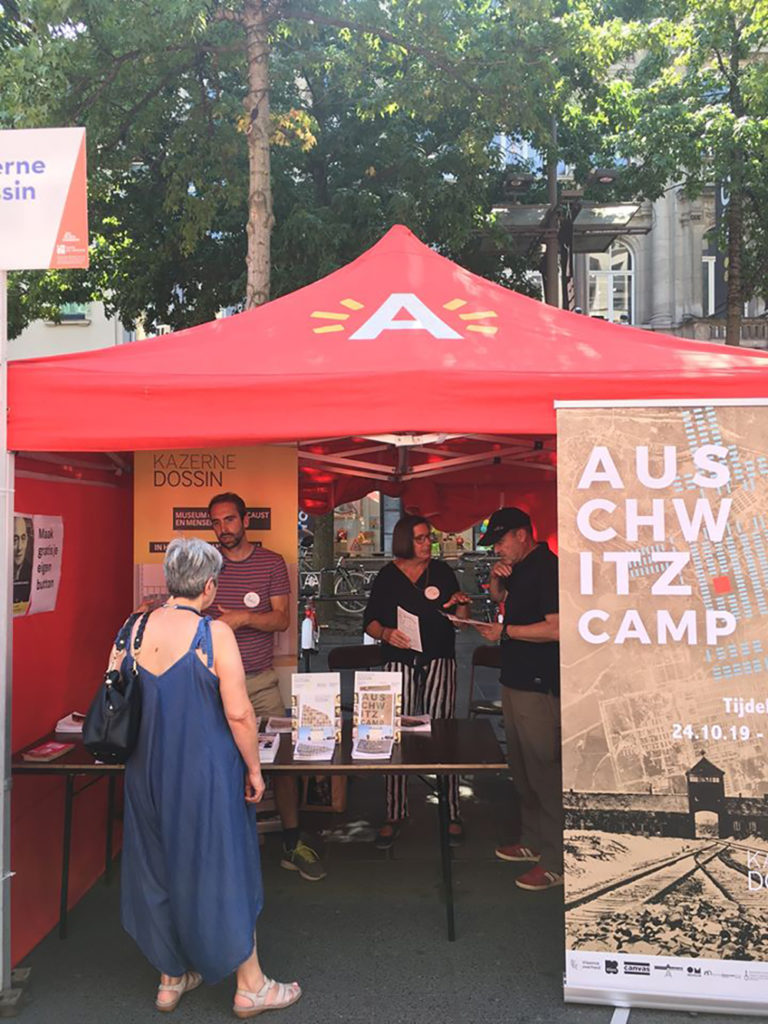
auschwitz.camp
An extensive campaign brought the temporary exhibition ‘auschwitz.camp’ to the attention of the general public. Thanks to cooperation projects with Canvas, Klara and Knack, the museum reached a large number of people by means of advertisements, radio and television spots. Cooperation projects with other partners, articles in the press and poster and leaflet campaigns also generated good visitor figures in the first couple of months of the exhibition.
Feedback from our visitors
I found the visit really interesting, but also moving. And I learned a lot. I hope that nobody in the world will ever have to experience this. Schools should certainly continue to go to Dossin Kazerne, because everyone should know this story. - 6th year pupil
Makes you think about the times we are living in. - Loek
Seeing someone of the same name/a distant relative on the wall among the 25,000 deportees sent cold shivers down my spine. A museum that makes you reflect on mechanisms which even today set people at each other’s’ throats. Excellent. - Wouter
Organization
Figures
- full-time employees22
- men9
- women13
- part-time employees7
- people joined5
- people left5
- seconded employees (integrated police)2
- Guides65
- Volunteers (hosts and stewards)11
- HPM coaches89
- Students on work placement8
In 2019 Kazerne Dossin added three new profiles to its organigram. The Collections & Research team appointed an archivist and the Business team a bookkeeper, while the Public Mediation team’s Polarization unit gained a new colleague whose task is to develop the ‘wij-zij’ network. In 2019 several guides and educational supervisors became eligible for the ‘bijklusser’ status. This new status gives pensionable guides and others who regularly carry out tasks for Kazerne Dossin the right to earn additional non-taxable income.
HR
Furthermore, Kazerne Dossin took further steps to ensure the well-being of its employees. Our organization recognizes the importance of a good work-life balance by encouraging teleworking and implementing a prevention policy against burnout. Kazerne Dossin continued to invest in its HR career policy (recruitment process, performance management, training and personal development programme). Finally, in 2019 Kazerne Dossin started putting together a new long-range policy plan. All employees were invited to have their say on the way forward for the institution over the coming years.

Subsidies and partners
Kazerne Dossin regards building bridges between past and present as part of its social responsibility. Several Belgian and European governments along with national and international partners and donors help us achieve this objective. As well as the regular grant from the Flemish Government, the City of Antwerp continues to support the daily running of the museum, memorial and documentation centre.
Project subsidies provided specific fields with a helping hand. Kazerne Dossin was able to reinforce its educational work and its research projects nationally and internationally by means of King Baudouin Foundation incentive programmes, and from within the European partner projects EHRI, RETHINK and HHEINA. For the special exhibition Auschwitz.camp, Kazerne Dossin received additional support from the Flemish government.

Friends and gifts
Forty-eight sympathizers started or renewed their commitment this year. In 2019 Kazerne Dossin was also able to count on financial donations from private individuals. The first ever afternoon specially for the Friends of Kazerne Dossin was held on October 27th 2019. It revolved around the newly opened special exhibition Auschwitz.camp. Curator Veerle Vanden Daelen discussed the exhibition with General Director Christophe Busch and Dutch visual artist and writer Hans Citroen, curators of the exhibition.
Security and infrastructure
In 2019 technical work was carried out as part of the renovation of the Memorial. In January 2020 all the scenography was completed ready for the re-opening of the building on January 26th 2020.
With thanks to
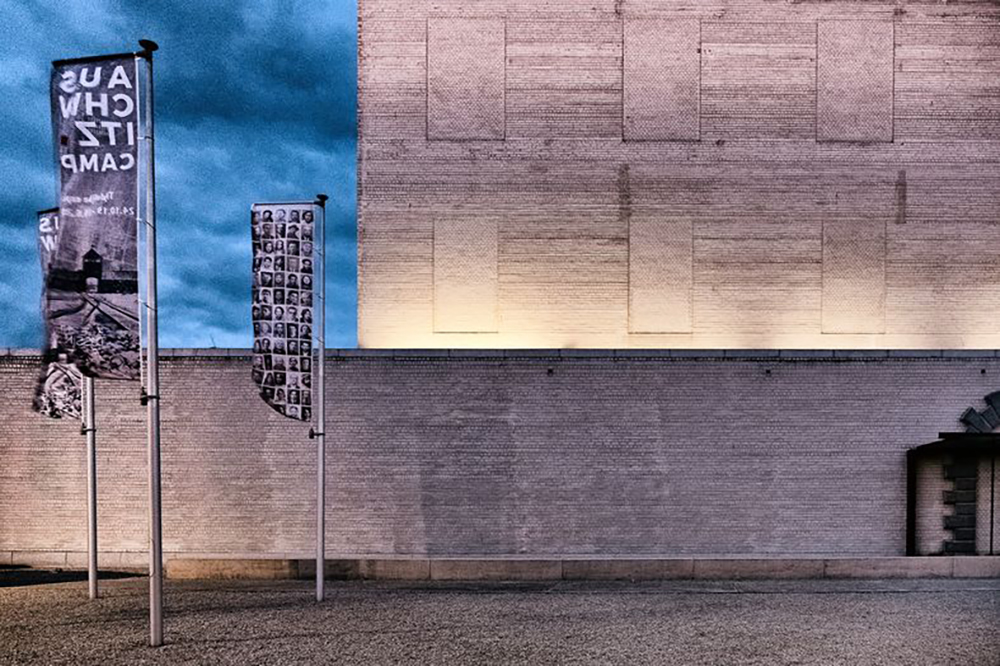
Everything achieved in 2019 was the result of the fantastic commitment of all the members of staff, guides, volunteers and students on work placement at Kazerne Dossin.
The members of the Board of Directors and General Meeting played a vital role in Kazerne Dossin’s successful year.
Kazerne Dossin also wishes to thank founding partners, sponsors and Friends. Special thanks must go to the family members and friends of victims for their donations and gifts.
Flemish Government—City of Mechelen—Conference on Jewish Material Claims Against Germany (Claims Conference)—International Holocaust Remembrance Alliance(IHRA) —Council of Europe—The National Lottery— Rothschild Hanadiv Foundation—Brussels-Capital Region—Department International Flanders—Flemish Ministry of Education— Flemish Ministry of Culture, Youth, Sport and Media—King Baudouin Foundation— SD Worx—European Social Fund (ESF)— Visit F—Visit Mechelen and MARCOM Mechelen – Stichting van het Belgisch Jodendom – AWDC – Foundation Simon & Lina Haïm – Foundation Ruth et Willy Berler – Grootoosten van België
Translation annual report: Barbara Otten, Alison Mouthaan

